Francesca and Henk-Jan's Backpacking Trip!
Monday, April 12, 2010
In Through The Jungle...
On the 9th of April Francesca and I woke up to some free breakfast (baguette for her, sticky rice for me) before heading out. We sought out a rather unique museum – very different from all the others on this trip: the Vietnamese Traditional Medicine Museum. It was a little out of the way, so we decided to take a taxi there. Our driver actually required the aid of another man to figure out where to go, but he got us there safe in the end. We walked inside and for just a few bucks each we got a guide to take us around the museum. The first thing we noticed was the beautiful architecture of the building. The whole building was crafted in the traditional Vietnamese dark teakwood style, consisting of a total of 18 exhibition rooms spread over six floors with plants, trees and herbs growing in every corner.
Our guide took us around and showed us ancient textbooks written by medicine men of many ages ago. Next, he showed us an altar with the statues of two of Vietnam’s most famous medical progenitors, Tue Tinh and Hai Thuong Lan Ong. The small piece is engraved with Chinese characters and scrolls, signifying the Chinese influence on healing techniques, as well as the overarching importance of China in Vietnamese daily life. An interesting difference between Vietnamese (and Eastern) healing and Western techniques lies in each technique's approach: the Western doctor will find what’s wrong with you (the problem) and fix that – the Eastern medicine man will find the cause of what’s wrong with you (the ROOT of the problem) and help you fix that. This small yet vital difference has seen the latter approach soar in popularity as Westerners and locals alike go to two newly founded schools that specialize in teaching ancient methods of healing.
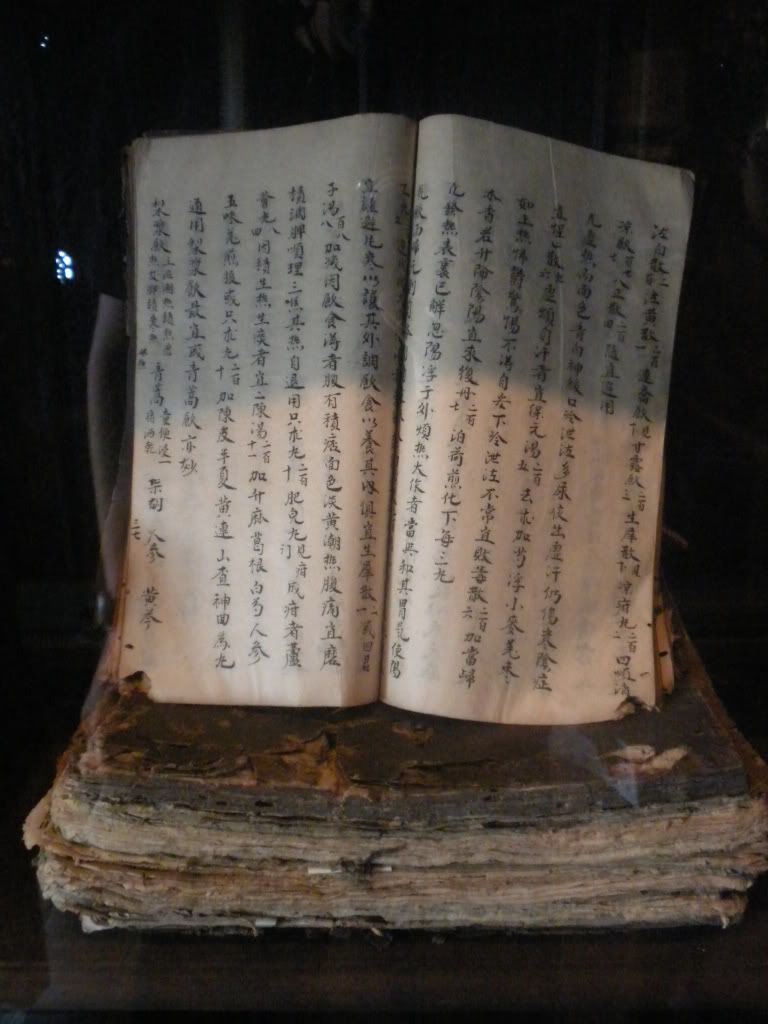

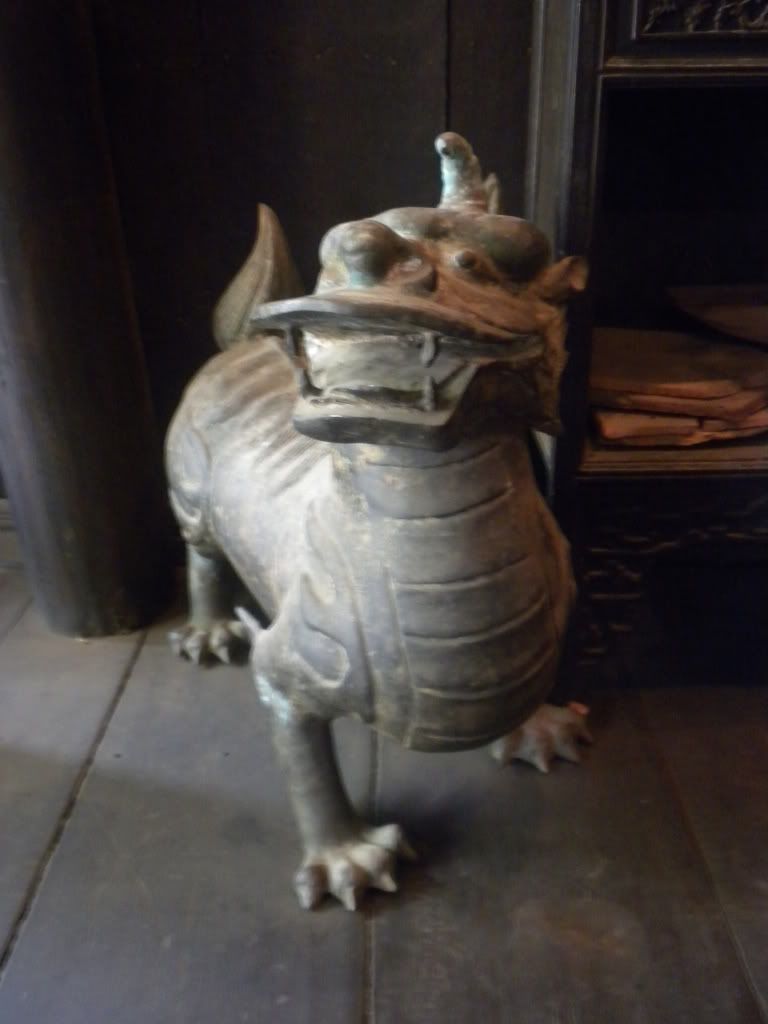
As we walked through the different floors we saw a large collection (over 3000 pieces!) of many different items once used by medicine men: knives, pestles and mortars, pots, medicine jars, scales, cabinets, printing molds, spirit gourds, and tea pots, just to name a few. Also interesting was the large amount of paintings and carvings on the walls. Most interesting was a wooden artwork depicting a large tree, on which the names of 100 well-known doctors from the 7th to 20th centuries are written. These physicians are credited with significantly contributing to the country’s development of medicine.

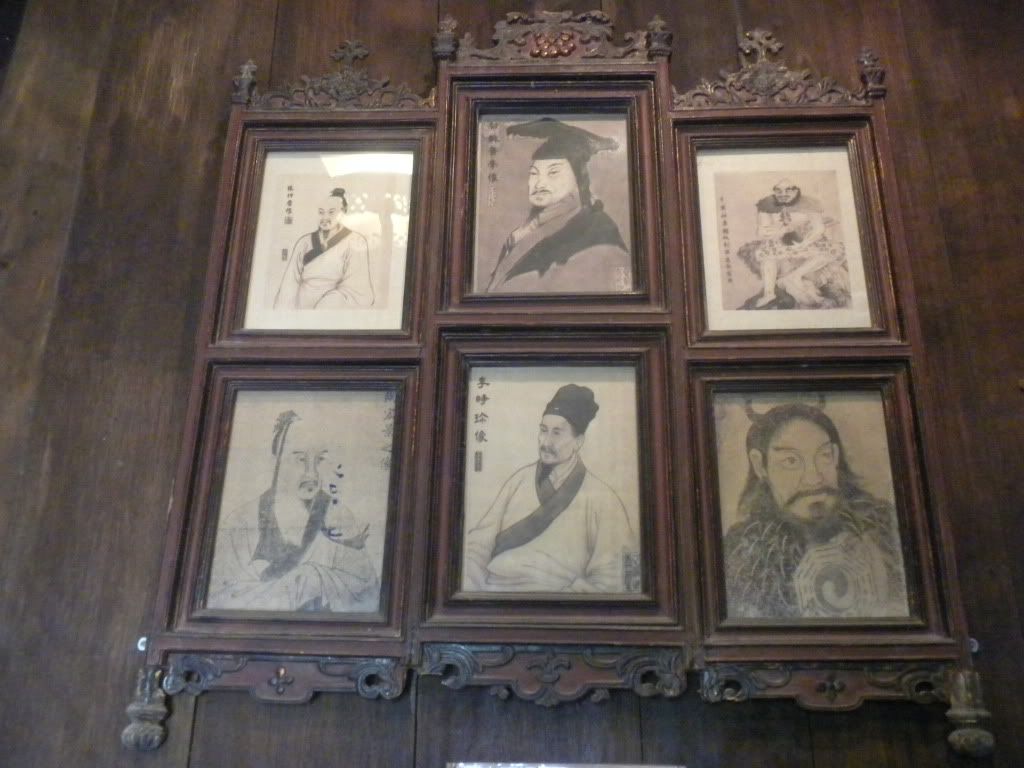
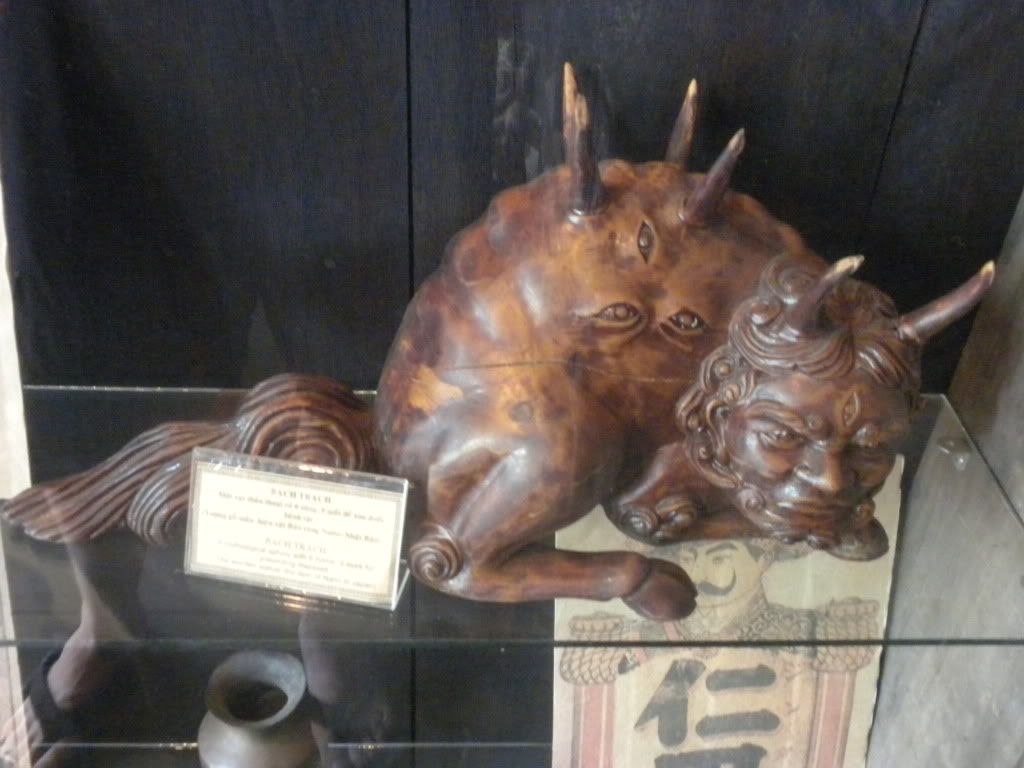
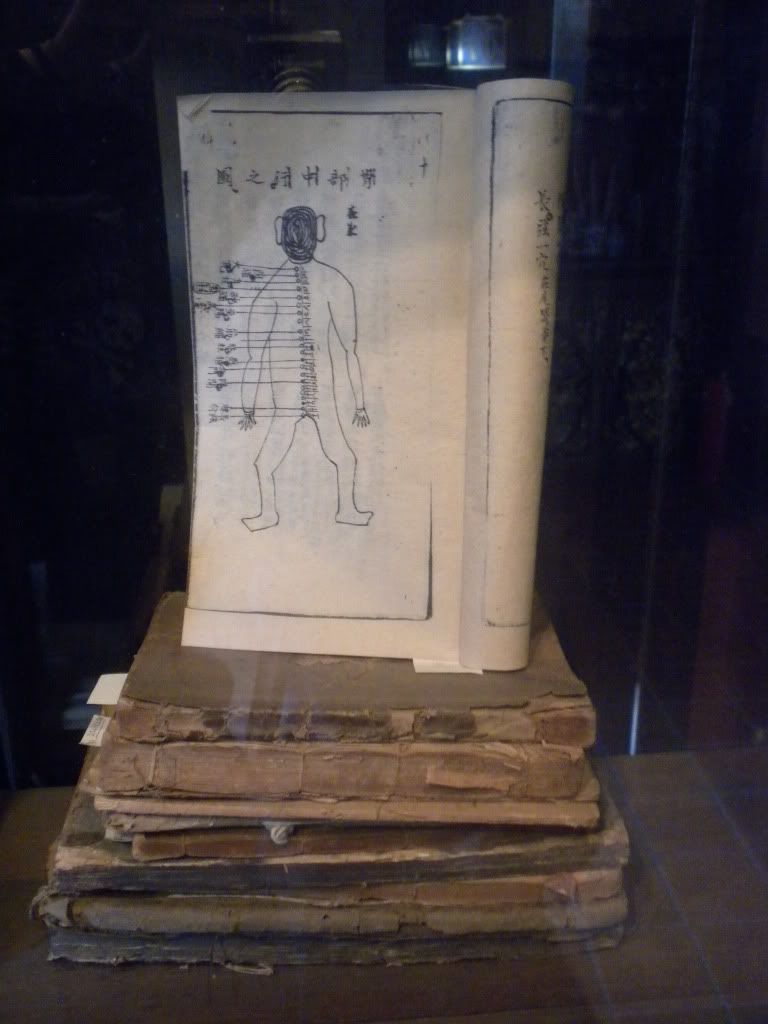
Francesca had found a description of the museum online and had been enticed by the promise of being able to try some medicine making on the premises. And indeed, one of the rooms was completely decorated as a medicine shop. The walls were lined with jars, stuffed with all sorts of ingredients. We put on traditional outfits and then ground powdered medicine using ancient machines operated by our feet or hands. We also took turns standing behind the counter, pretending to weigh or sell goods.
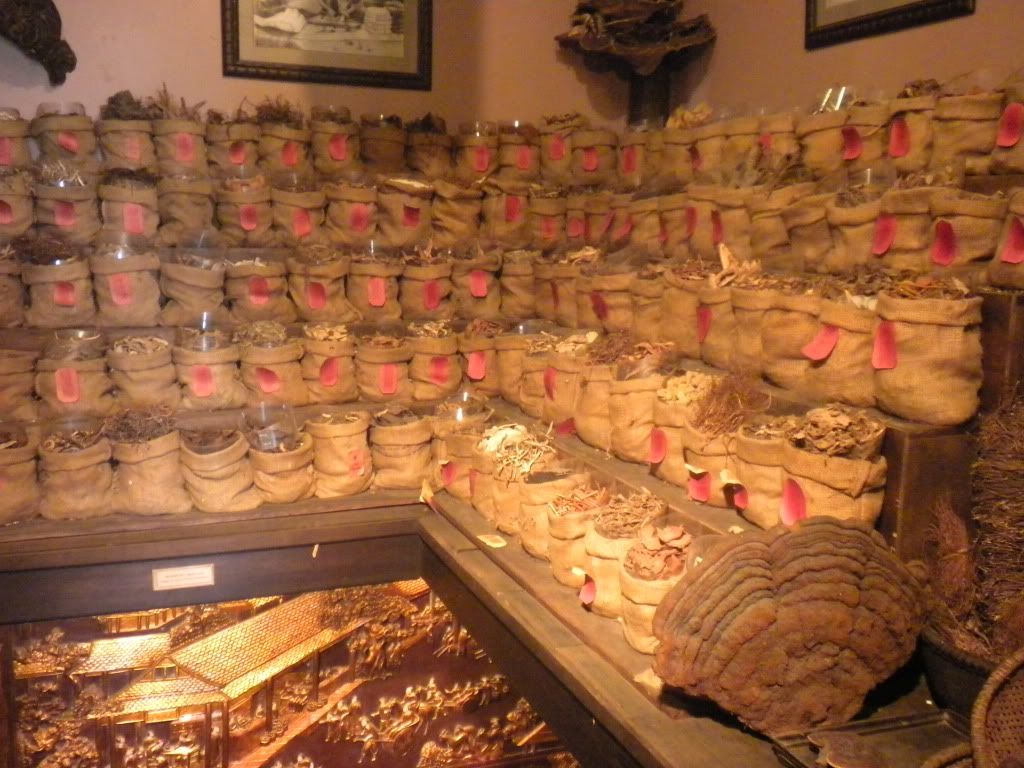
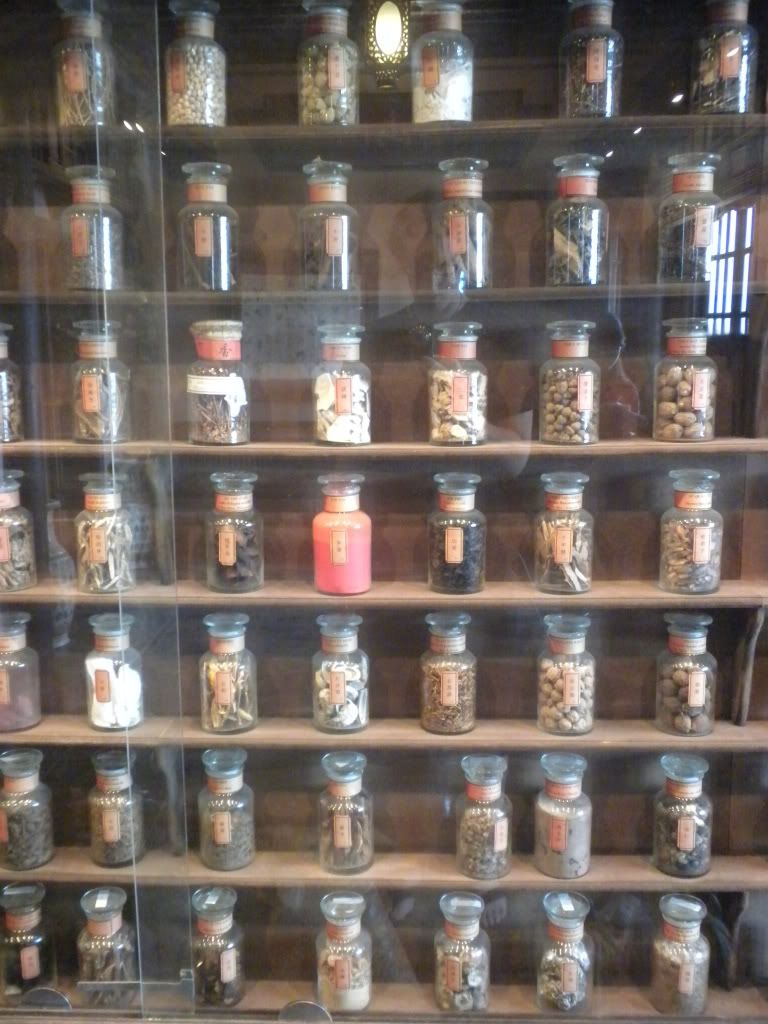
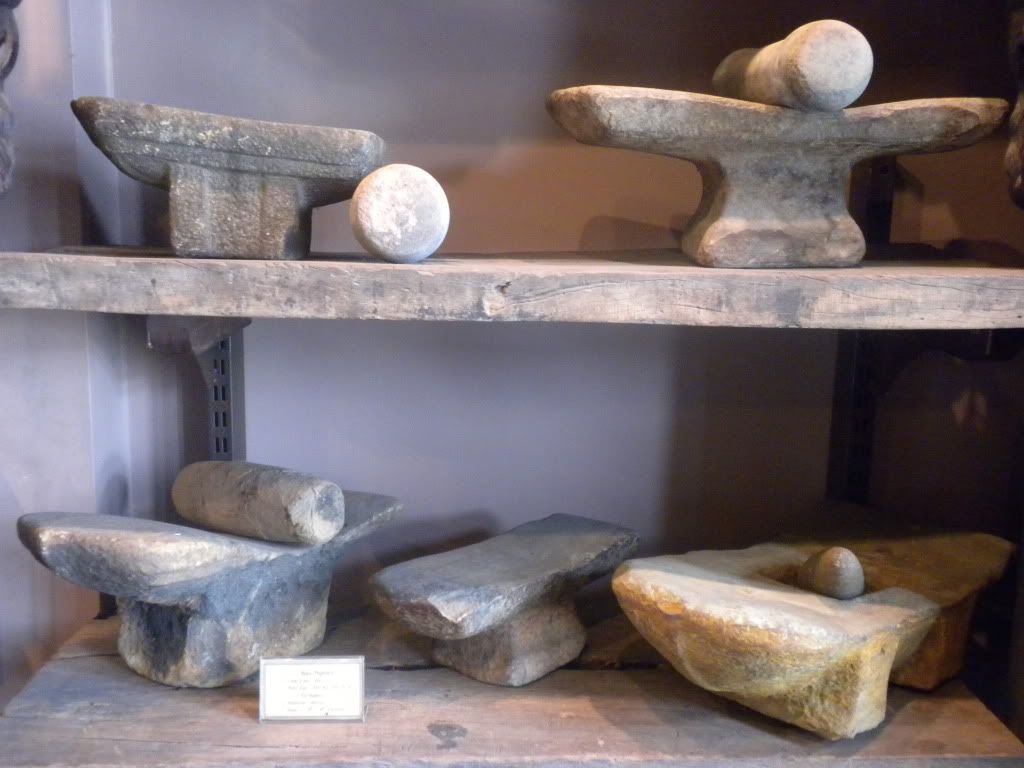
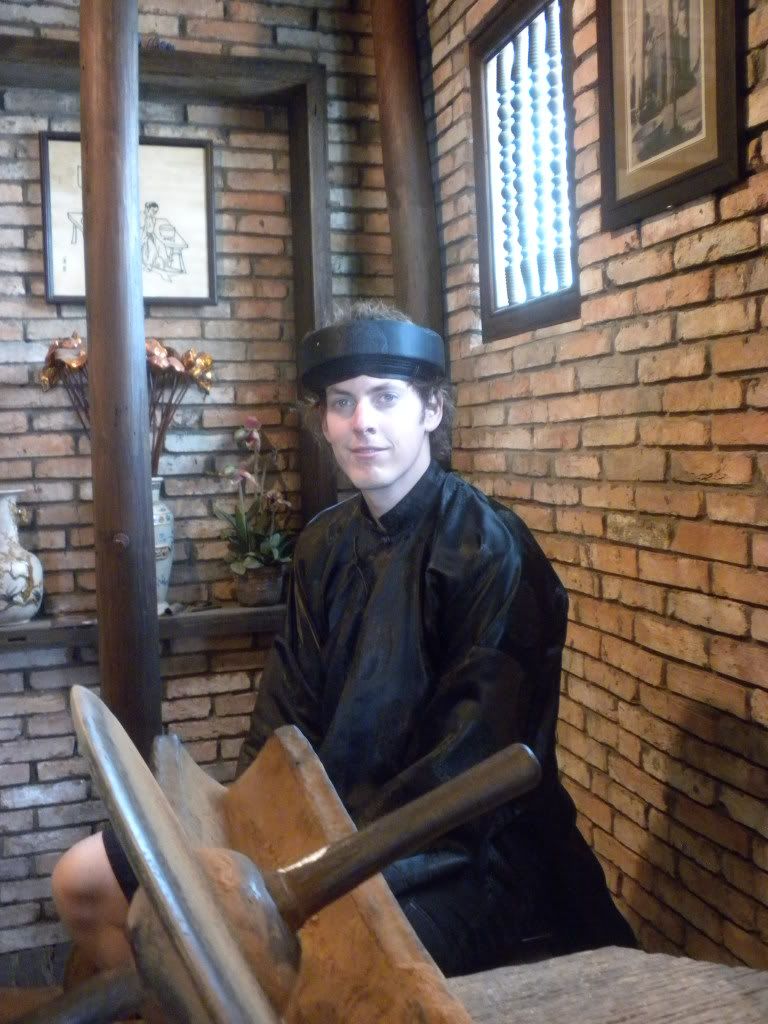
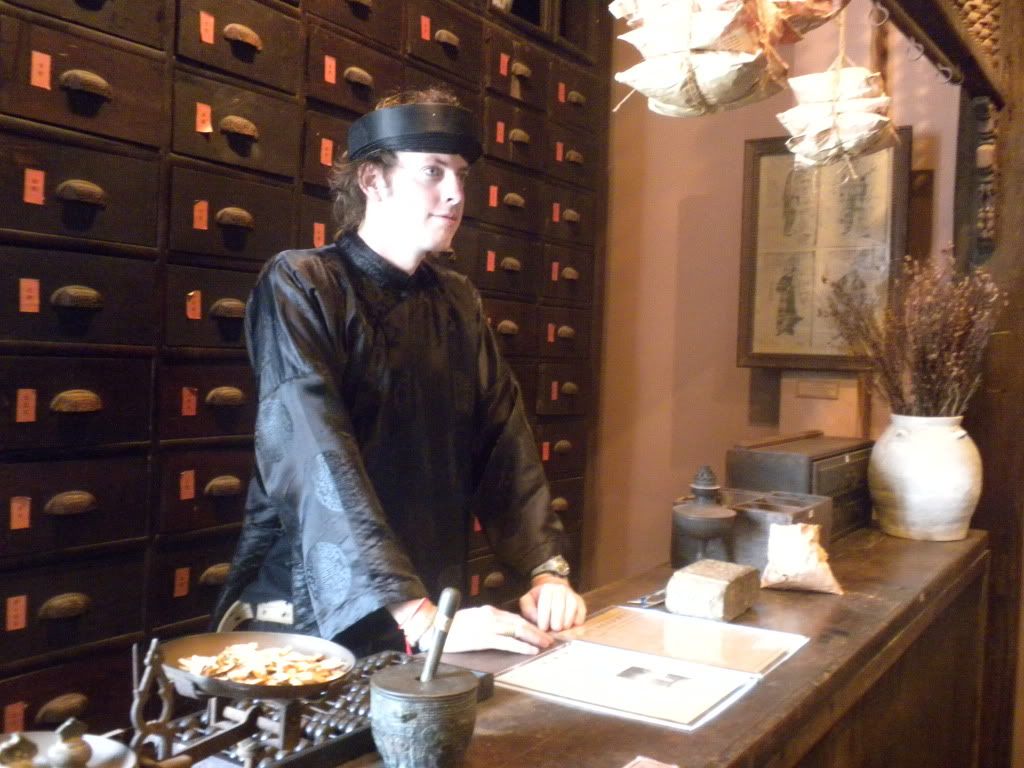
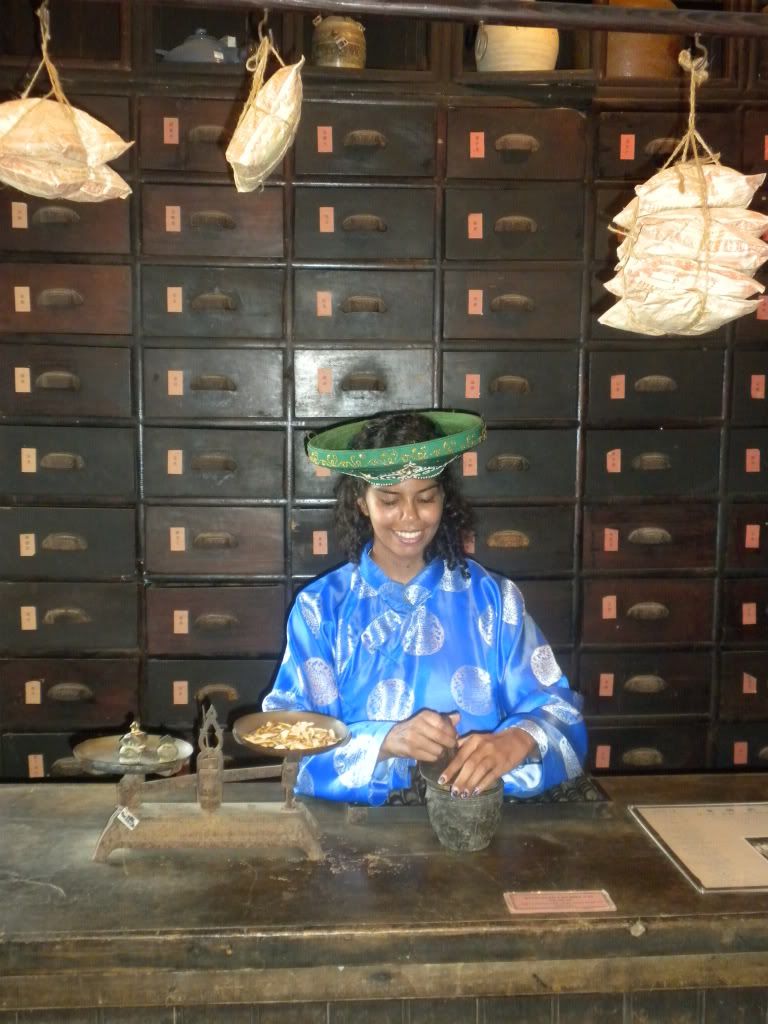
The tour ended with a video presentation about traditional medicine in the modern world. It showed how the ancient techniques still hold validity in this increasingly technocratic era. We were impressed by the accurate ways patients are diagnosed – not with MRIs, but by deciding their energy level and taste, listening and observing carefully, finding a cure that way. We got a cup of traditional healing tea before we left, and I bought some mushroom-based medicine which is supposed to raise your energy-levels and help you fight off common colds. Let’s see if it works!
Francesca and I decided to find a renowned pagoda nearby, and with the directions of the guide in my head we had no problem finding the Chinese Phuoc Dien temple. The large statues inside were impressive, but we were still 'watted-out' and left after a few pictures. Instead, we took a taxi to the Reunification Palace and walked to Window’s, a bar/restaurant we had seen the day before. We sat down at a hip table in the back, music blaring loudly from the speakers as TVs all around us showed a wide variety of shows. Francesca treated herself to a small cheese pizza, whilst I got a large salmon salad and a peach ice tea. The food tasted good, but the music got to us a little. It made us leave right after finishing our plates.
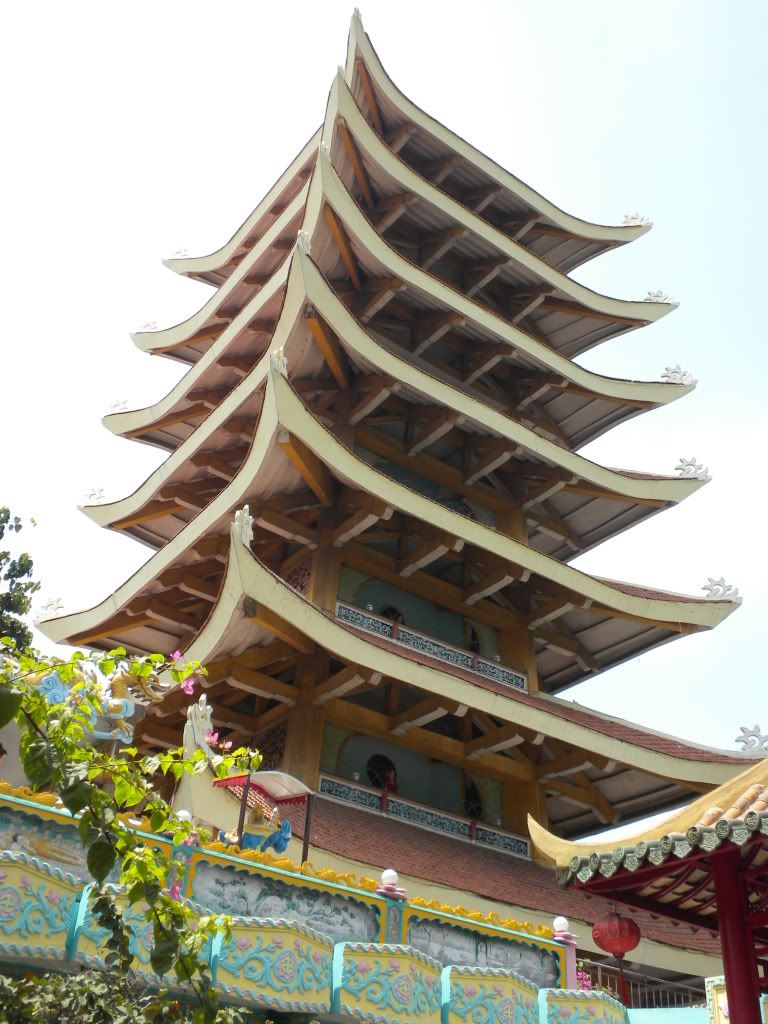
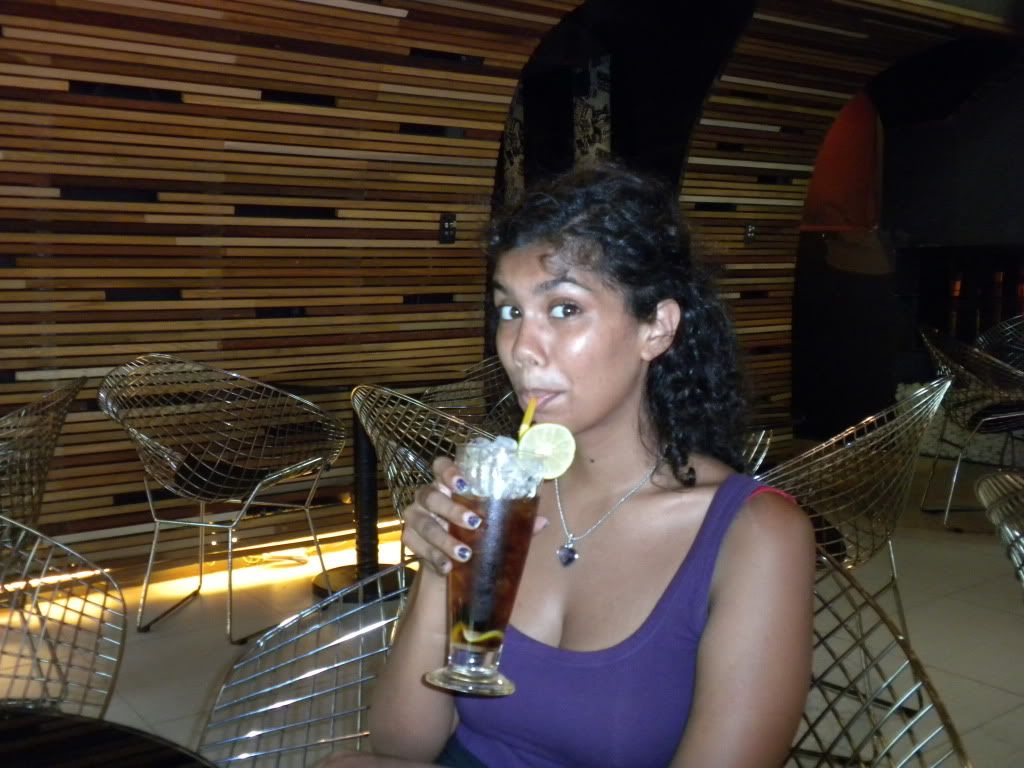
We wanted to finish our exploration of the War Remnants Museum, thus it became our next stop. Francesca and I were hoping to catch the documentary we had missed the day before, but when we got to the room it was supposed to be in, it had been emptied out and we heard construction had been planned. No documentary for us. Not that much of a problem, since we still had quite a lot of exploring to do. Francesca already told you about Agent Orange, so I will share with you some of the other stories we read about at the museum.
The first floor, besides showing the atrocious pictures of Agent Orange and napalm victims (that Francesca told you about), also housed photos of other war crimes committed by American troops. We saw them throwing prisoners out of helicopters, kicking helpless civilians and proudly standing around with the remains of a shredded Vietnamese man. Pictures of victims of napalm-bombings also left little to the imagination. Thoroughly impressed and slightly nauseated Francesca and I entered a room that showed elementary school drawings with world peace as the topic. Some also dealt with the war. I found a definite favorite in the depiction of Agent Orange victims.
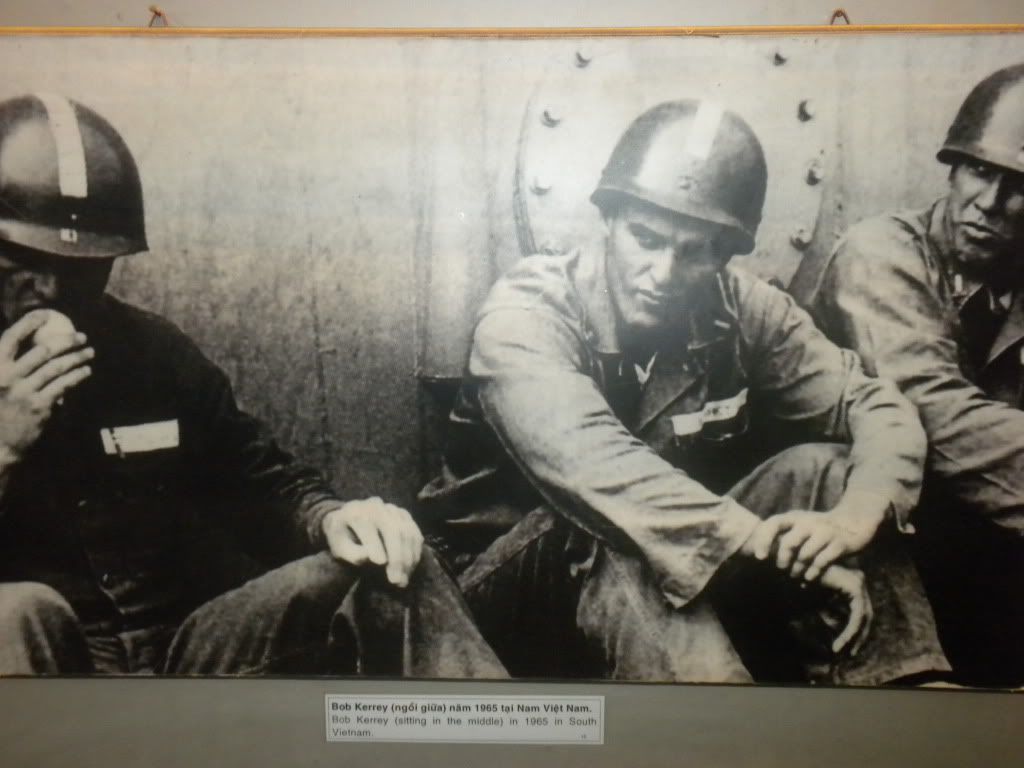
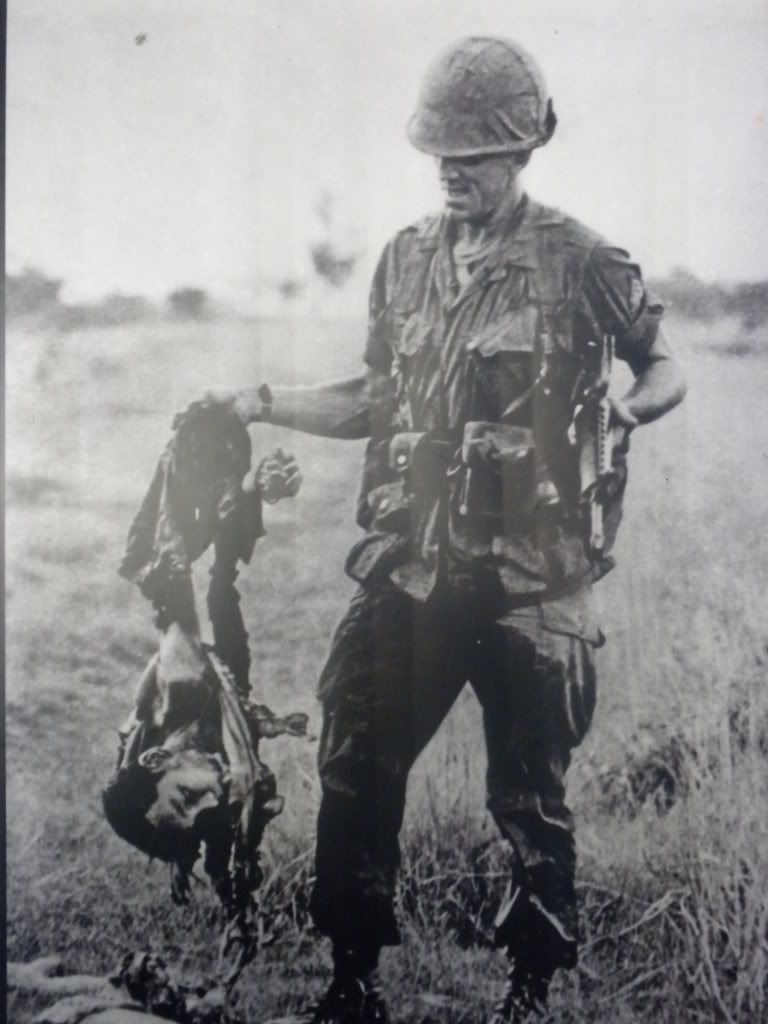
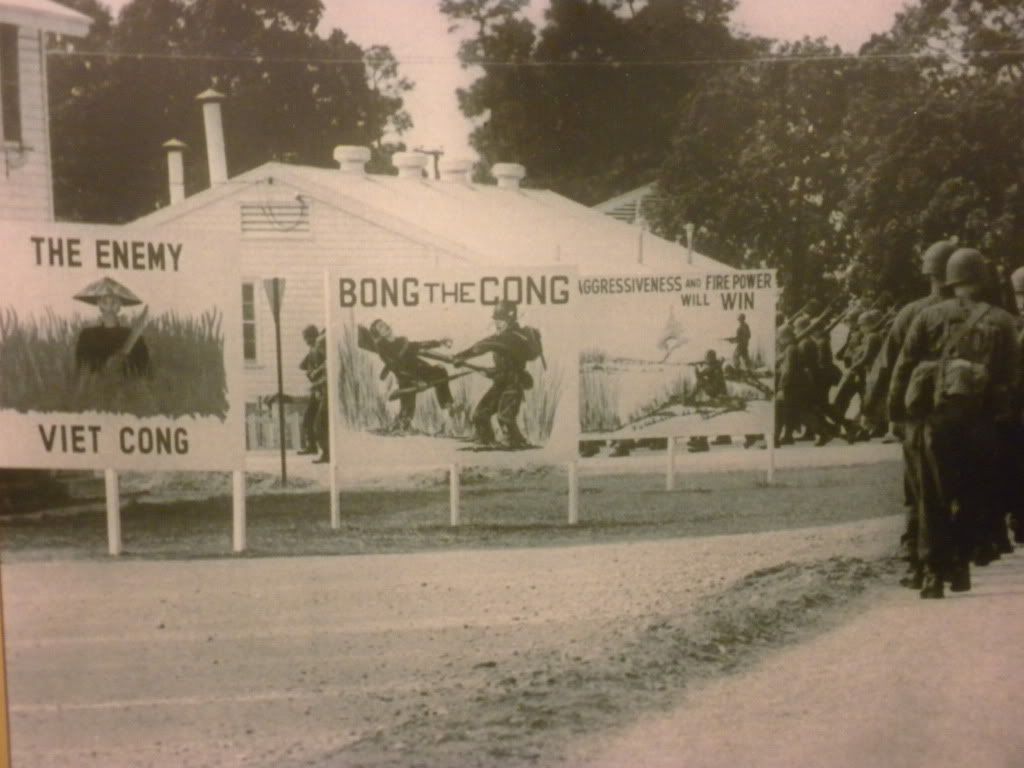
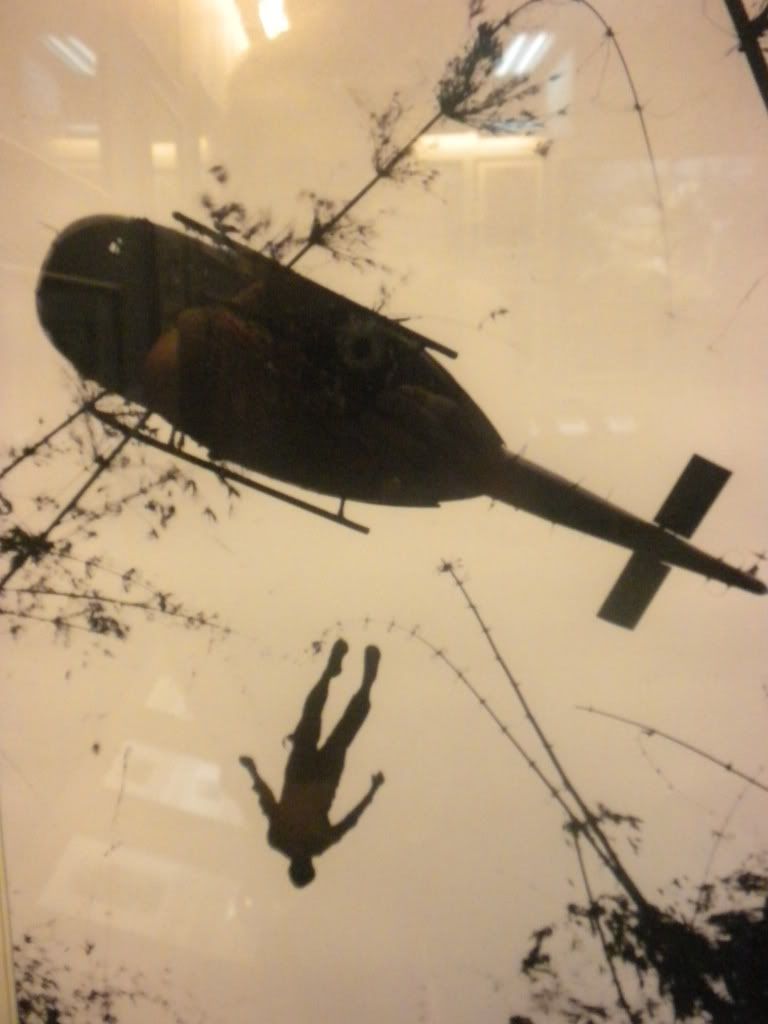
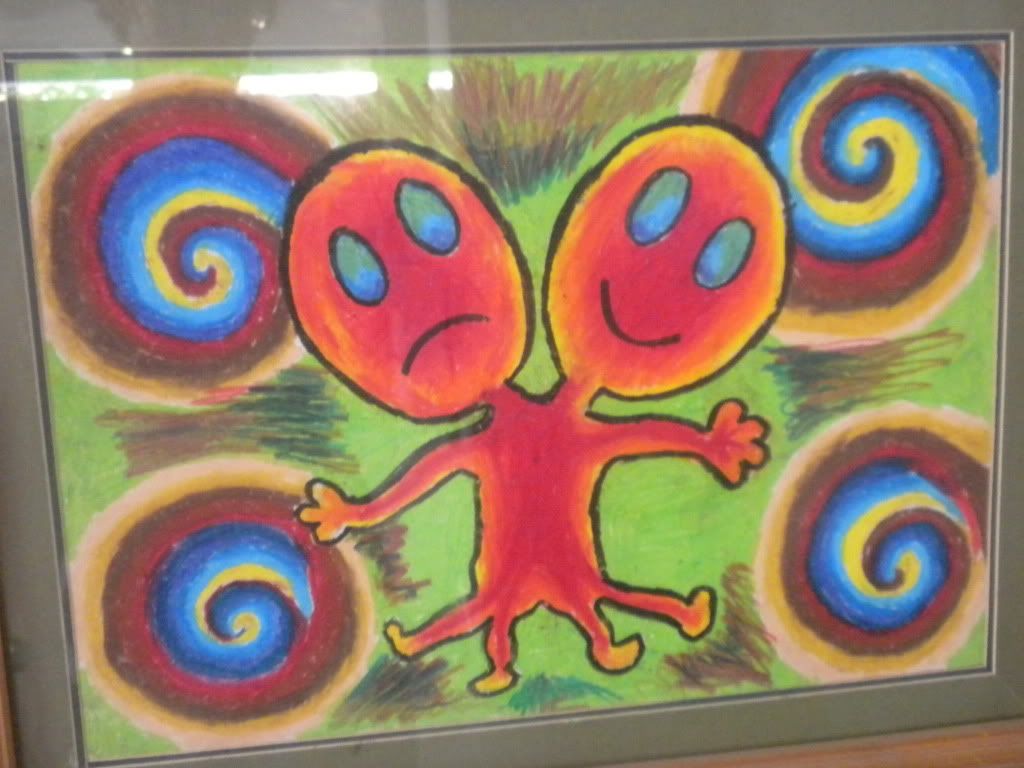
Francesca and I headed upstairs, where we got a thorough history lesson about the Vietnam War. I’ll summarize quickly with Wikipedia’s help:
"The United States entered the war to prevent a communist takeover of South Vietnam as part of their wider strategy of containment. Military advisors arrived beginning in 1950. U.S. involvement escalated in the early 1960s, with U.S. troop levels tripling in 1961 and tripling again in 1962. U.S. combat units were deployed beginning in 1965. Operations spanned borders, with Laos and Cambodia heavily bombed. Involvement peaked in 1968 at the time of the Tet Offensive. After this, U.S. ground forces were withdrawn as part of a policy called Vietnamization. Despite the Paris Peace Accords, signed by all parties in January 1973, fighting continued.
The Case-Church Amendment, passed by the U.S. Congress in response to the anti-war movement, prohibited direct U.S. military involvement without congressional authorization after August 15, 1973. U.S. military and economic aid continued until 1975. The capture of Saigon by North Vietnamese army in April 1975 marked the end of Vietnam War. North and South Vietnam were reunified the following year.
The war exacted a huge human cost in terms of fatalities, including 3 to 4 million Vietnamese from both sides, 1.5 to 2 million Laotians and Cambodians, and 58,159 U.S. soldiers. By this war's end, the Vietnamese had been fighting foreign involvement or occupation in various wars for over a hundred years."
Throughout our trip in Vietnam we’ll learn more about the war and we will describe events in more detail as we reach the sites where they took place.
The following room showed impressive paintings by local artists. Another portrayed the war through the eyes of two Japanese photographers. The black and white pictures gave another face to the war, closely dealing with the soldiers’ lives on the front. It was very intriguing to study the faces of the young boys, thrown into a war with no idea what to expect. Yet another room showed how the world finally caught on to the horrors of the war, as suddenly protests ensued all over the globe. Posters from many different countries depicted the saddened faces of poor Vietnamese children, begging for the war to end.
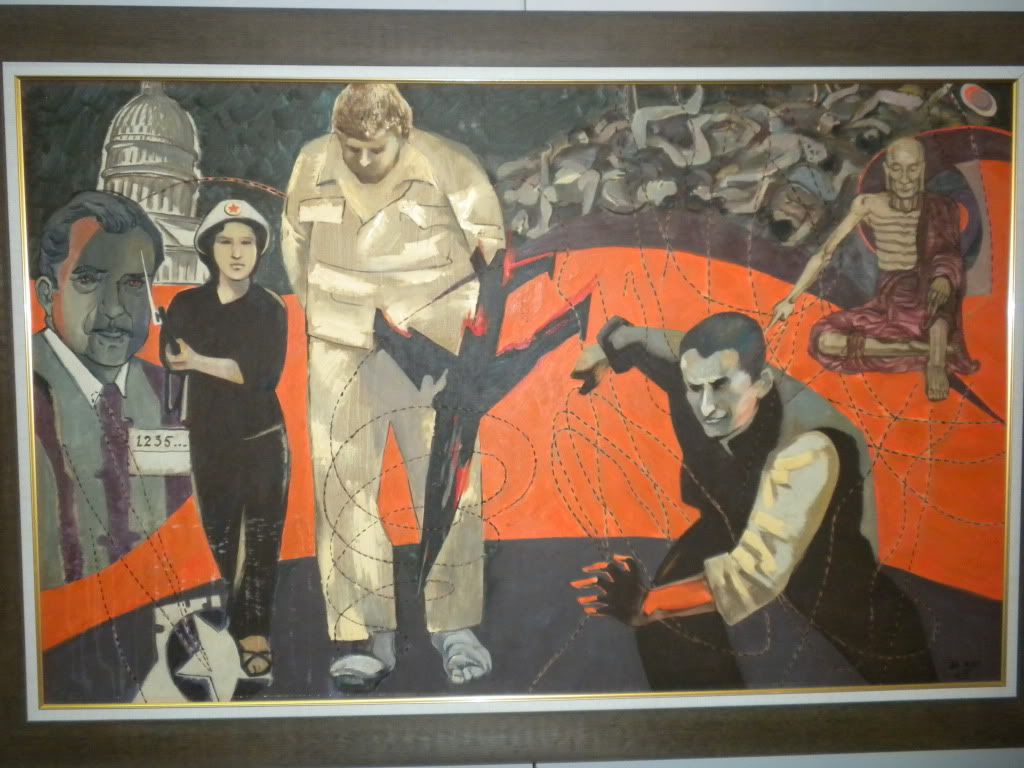
As my little summary explained, the war wasn’t just between the Americans and the Vietnamese. The North fought the South as Communism and Capitalism went head to head. Prisoners of War were taken on both sides. Outside the museum we saw a remake of two typical prisons of the time, the Con Dao and the Phu Quoc jail and all the breaches of the Geneva-convention that came with them. Phu Quoc was known as a “Political Correctness Camp,” where in reality over 4000 prisoners died of torture.
The pictures we saw, once again, had us shivering. We saw images of skin-over-bone men with heavily mutilated limbs. We saw pictures of skulls with 3-4 inch long nails driven into them, once belonging to living human beings. We read about horrible torture techniques, such as nails being pulled out and acid being poured on, teeth being smashed, burned sex organs and mouths, broken bones and prisoners being boiled alive. There seemed no end to the cruelties. The “Tiger Cages” were yet another infamous punishment: a tiny cell measuring no more than 2.7m by 1.5m by 3m was filled with up to 14 prisoners during summer time. The heat got so intense they had to take turns taking fresh breaths of air. The guards poked at them with sharp sticks, beating them when they so much as moved. Food was scarce, and water equally hard to come by. Death rate in the “Tiger Cages” was insanely high. Another version of the “Tiger Cage” was an open air variation, made of barbed wire. The cage was so low from the ground that standing was impossible. The sun burning all day long made the experience worse, and combined with guards harassing prisoners from all sides made this another death trap. We saw pictures of survivors and could not possibly imagine the pain they’d gone through.
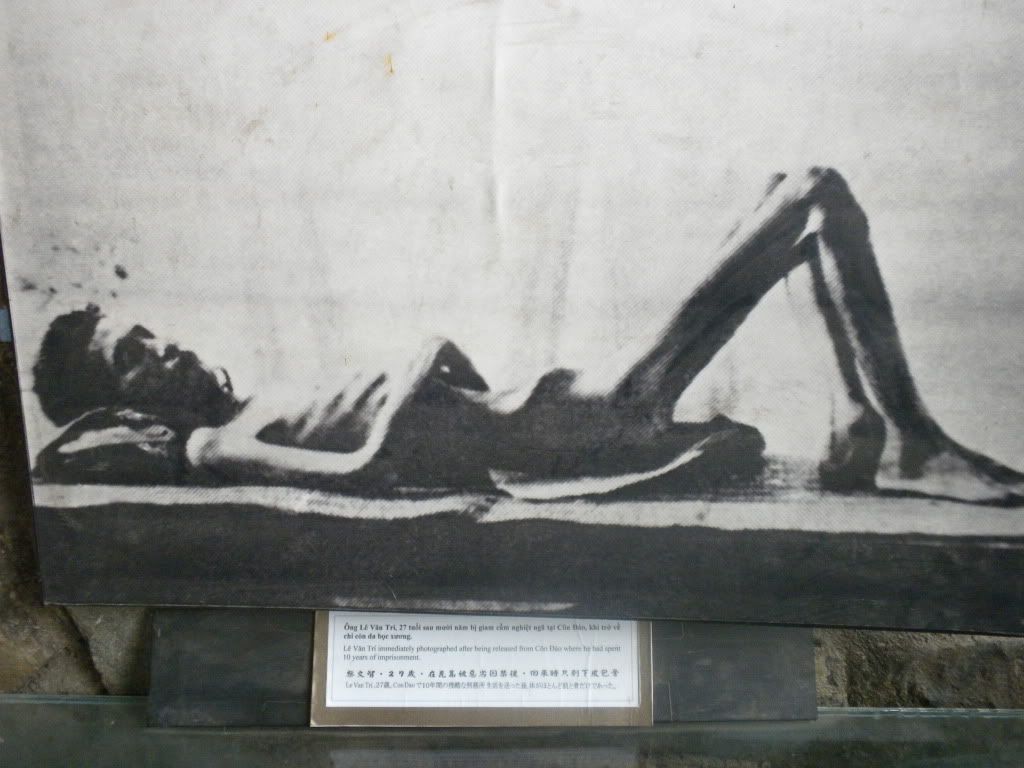

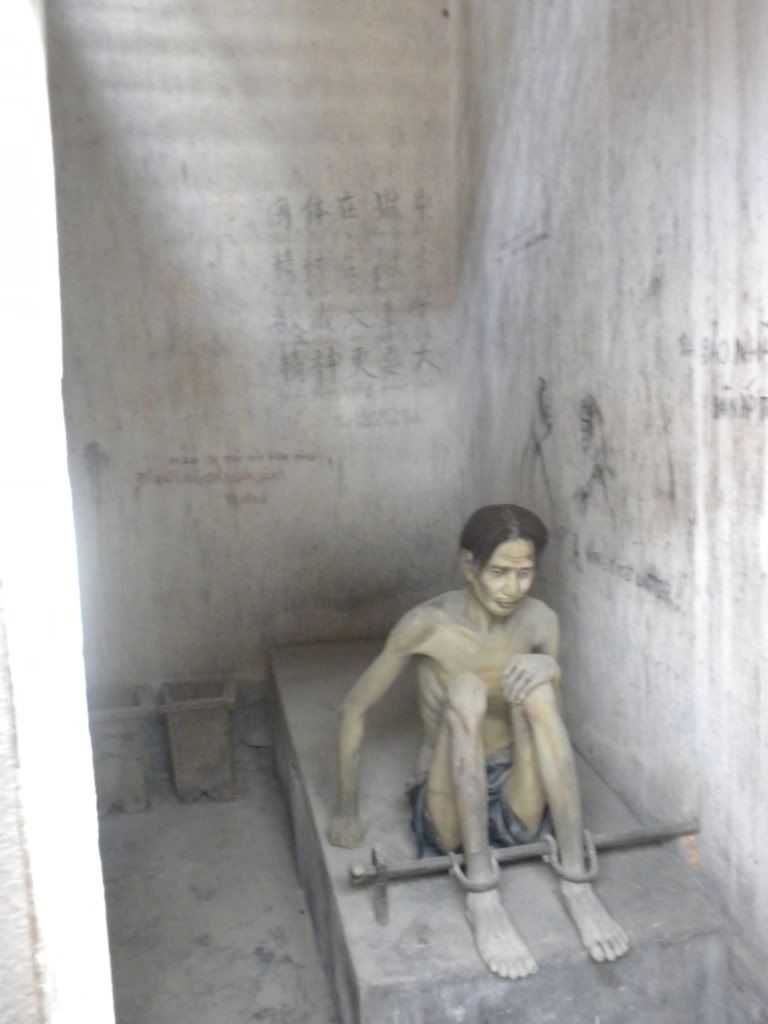
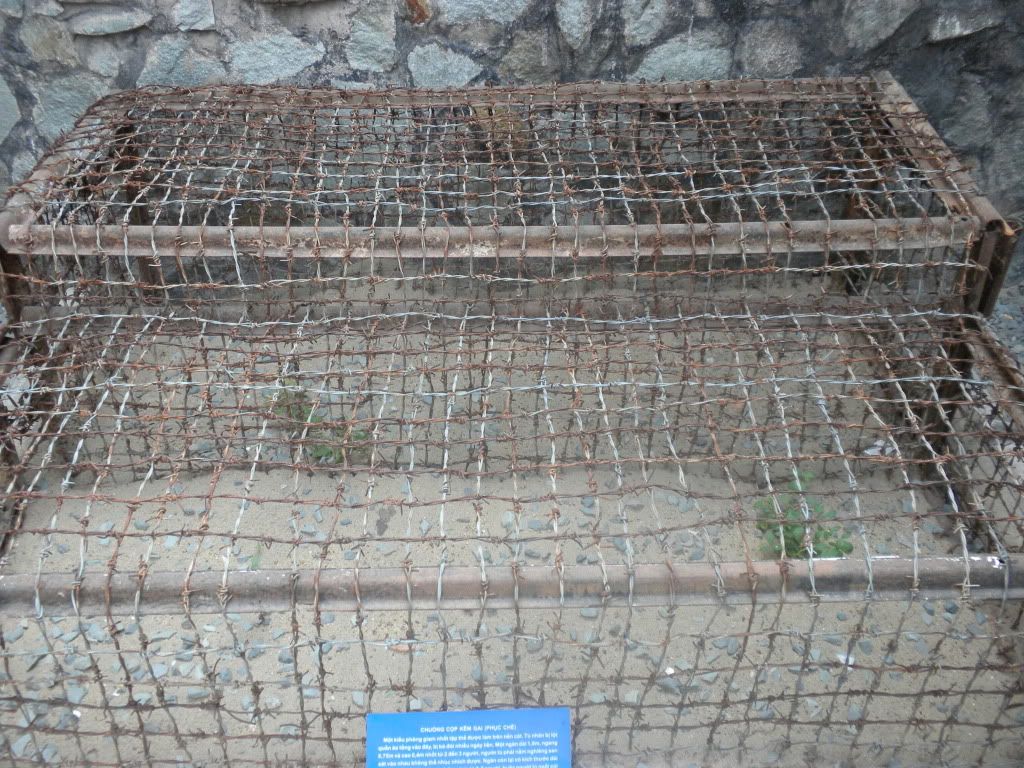
We left the prison section and ended up looking at several helicopters, fighter jets, tanks and large artillery used during the war. They looked war-ready still. At this point we’d had our fill of information about the more recent history of Vietnam and decided to immerse ourselves in the more distant past. The History Museum was quite a long walk away, so we decided to get a taxi. Some annoying guys were standing outside and smilingly offered a ride for 150.000 dong (about 8 bucks) for a short ride – outrageous! I laughed in his face, told him he was crazy and found an honest driver around the corner.
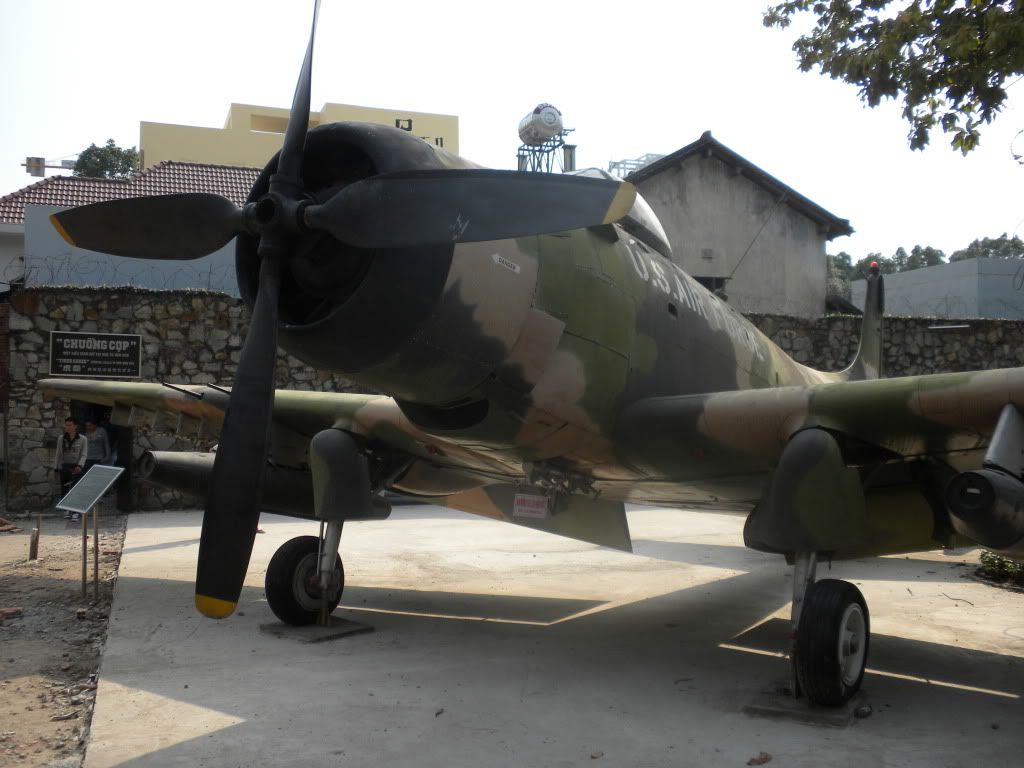
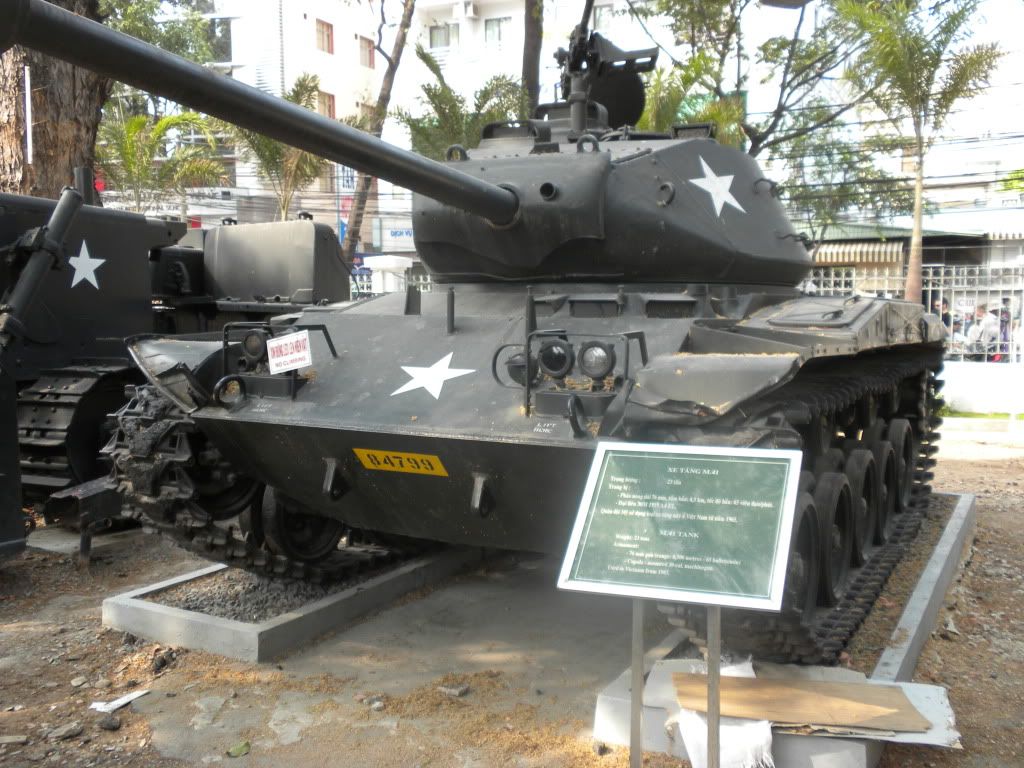
A few minutes later we were dropped off at the museum and headed inside. The museum exhibits its collection in two parts: part one exhibits the history of Vietnam from the times when the area was first settled (about 300,000 years ago) to 1930 – around the time the Vietnamese Communist Party was born. Part two covered a wider range of cultural artifacts from both the country itself and surrounding nations.
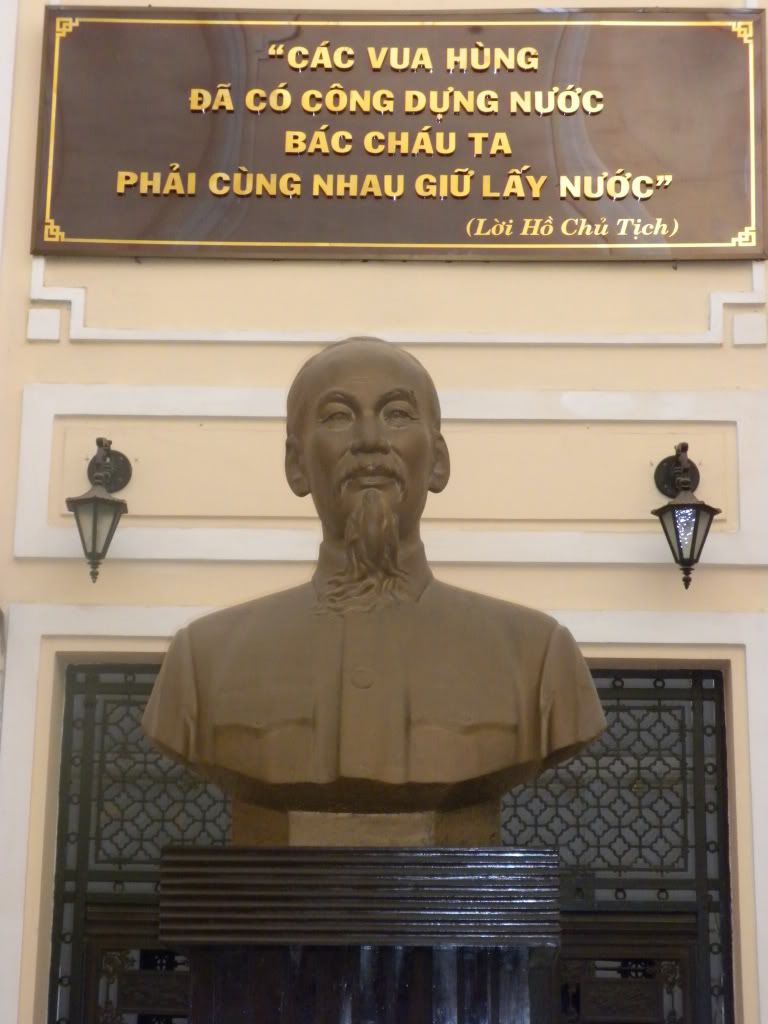
We followed the timeline, working our way through the different halls. We started with ancient crushed skulls and paintings of cave-people, followed by explanations of the different dynasties that ruled the lands since the founding of King Hung’s dynasty 4000 years ago. Interesting little dioramas showed battles fought for the king and country throughout the many centuries that followed. Part two started with a brilliant old Buddha statue, made in the 7th century out of Sao wood. The collection also included some pieces from Angkor Wat, which we skipped to find an ancient mummy.
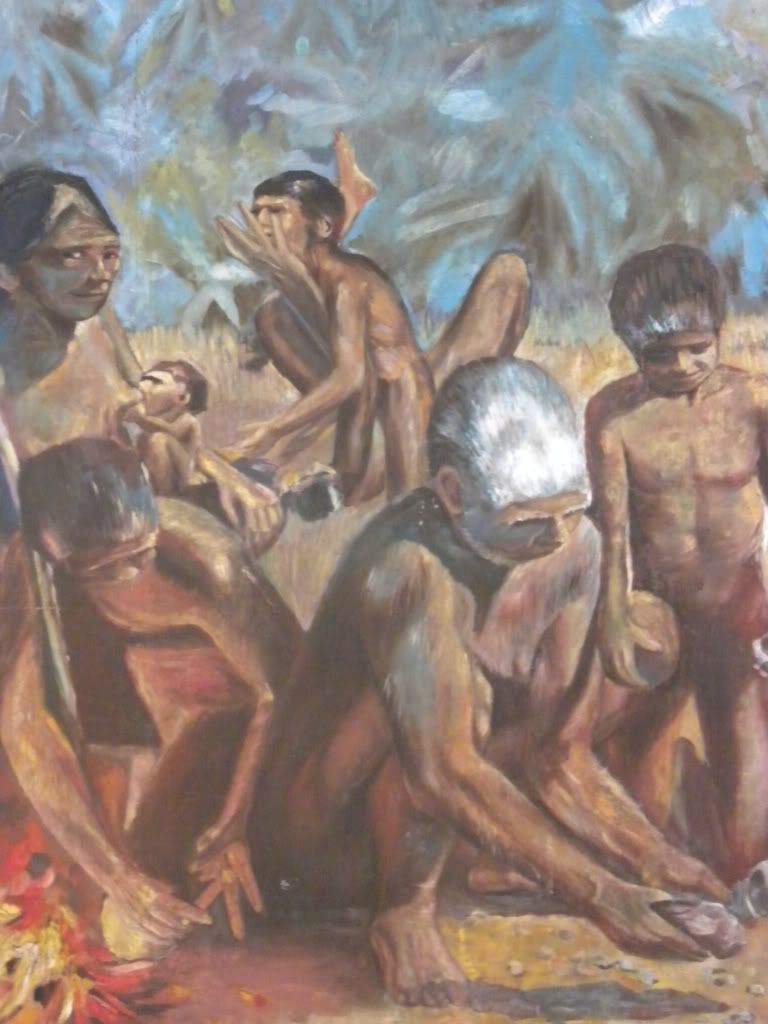
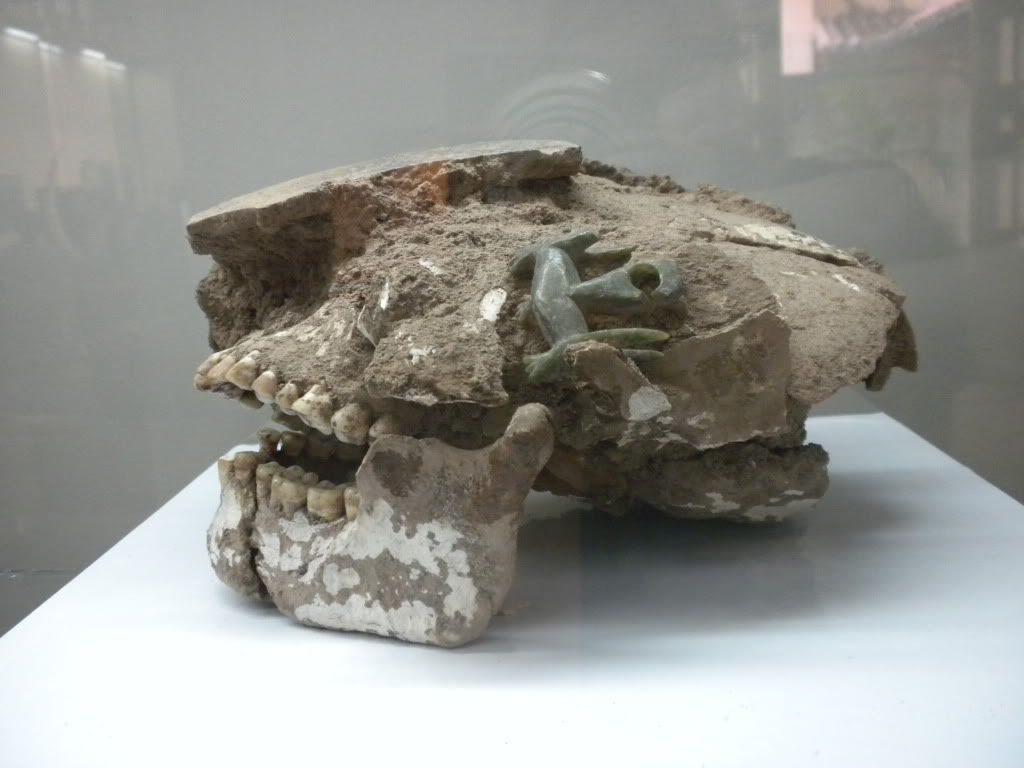
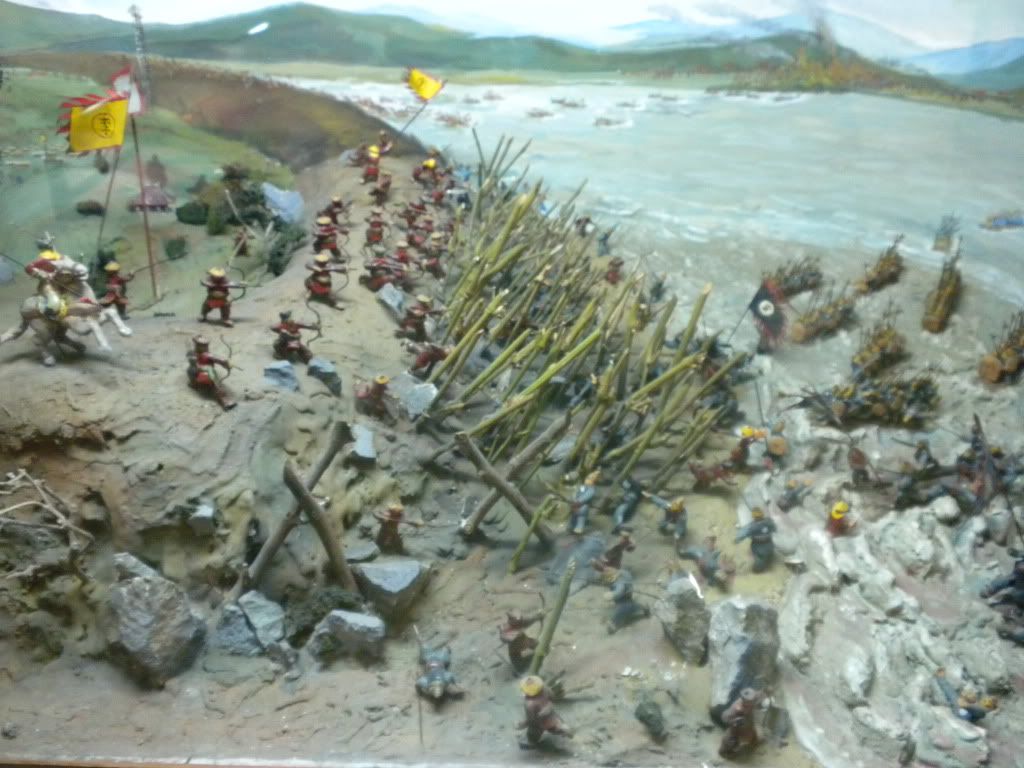
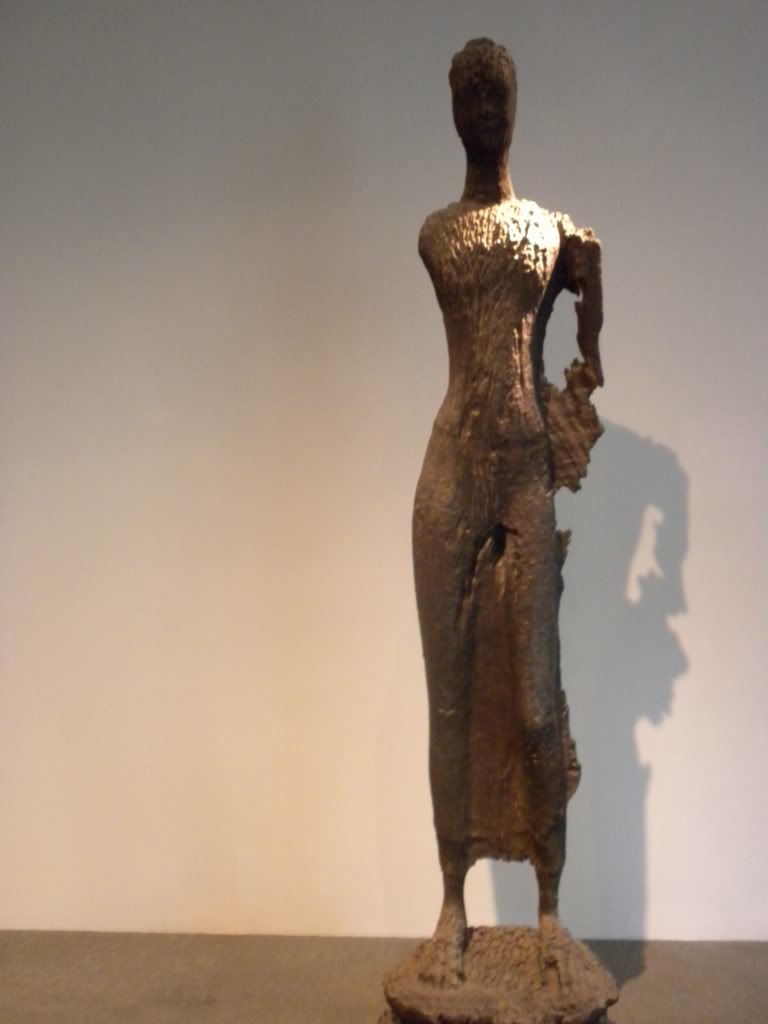
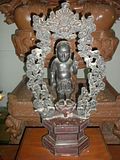

The explanation read: “In 1994, at Xom Cai, ward 8, district 5, Ho Chi Minh City, the mummy was discovered in the rather big barrow, 60 square meters. It was buried two abreast in a mortar compound. On the stele there were only 3 Han scripts: “Ky Ty Nien” (“The Year of the Snake.”) The corpse was buried with the style of traditional Vietnam: in-coffin, out-sarcophagus, with full of shroud and grave goods. All of them were soaked in the red solution. According to the first research, this is a Vietnamese woman, aristocratic class, about 60 years old, 1.52 meters high, named Tran Thi Hieu, died in 1869.”

The still life-like face stared back at us as we scrutinized the tiny woman’s public resting place. The rest of the second part of the museum was a little less interesting, covering some wood-carvings, clothing and local instruments. Closing time was approaching and we were herded out when we had just finished the last room. It was now 4:30 PM and we’d been out all day. Right across the street from the museum we spotted a nice-looking temple, so we went to have a look. The Hung Kings Temple was built in 1926, to remember the Kings of the first Vietnamese dynasty. It turned out the place was just closing, so we left again. Before heading back to the guesthouse we took a few more pictures of the Notre Dame, since Francesca had a doctor’s appointment at 5:00 PM. After the appointment we made our way to a mall across the street for a Pizza Hut dinner I'd promised Francesca. After a bite, we were on our way back to the hostel.
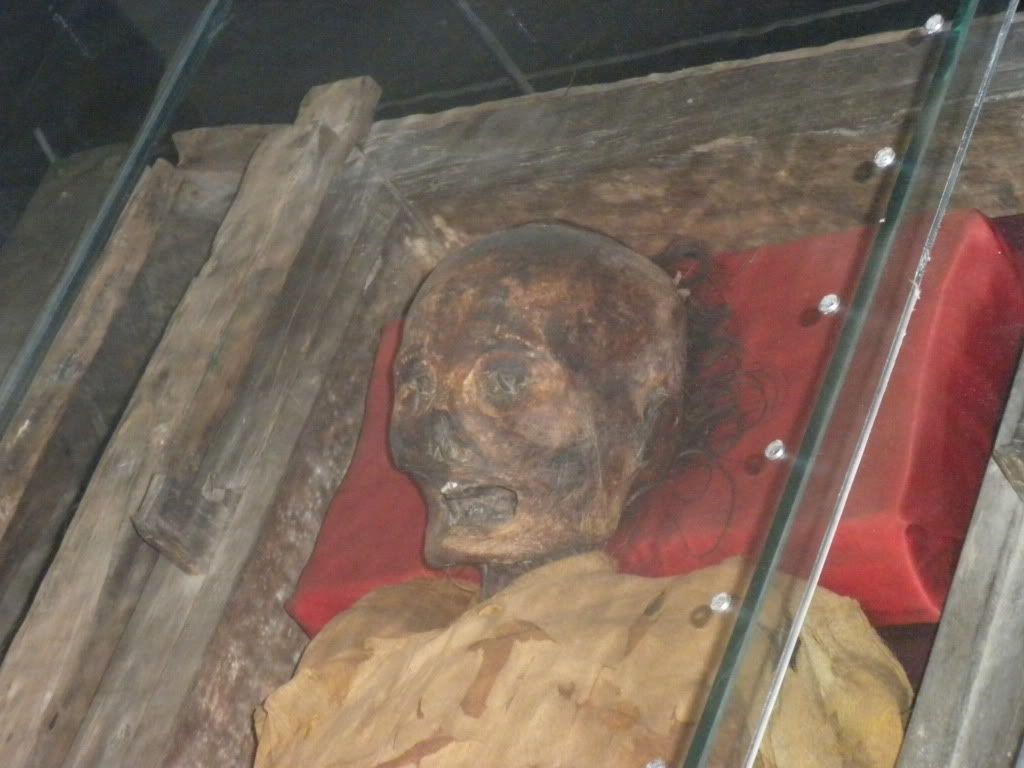
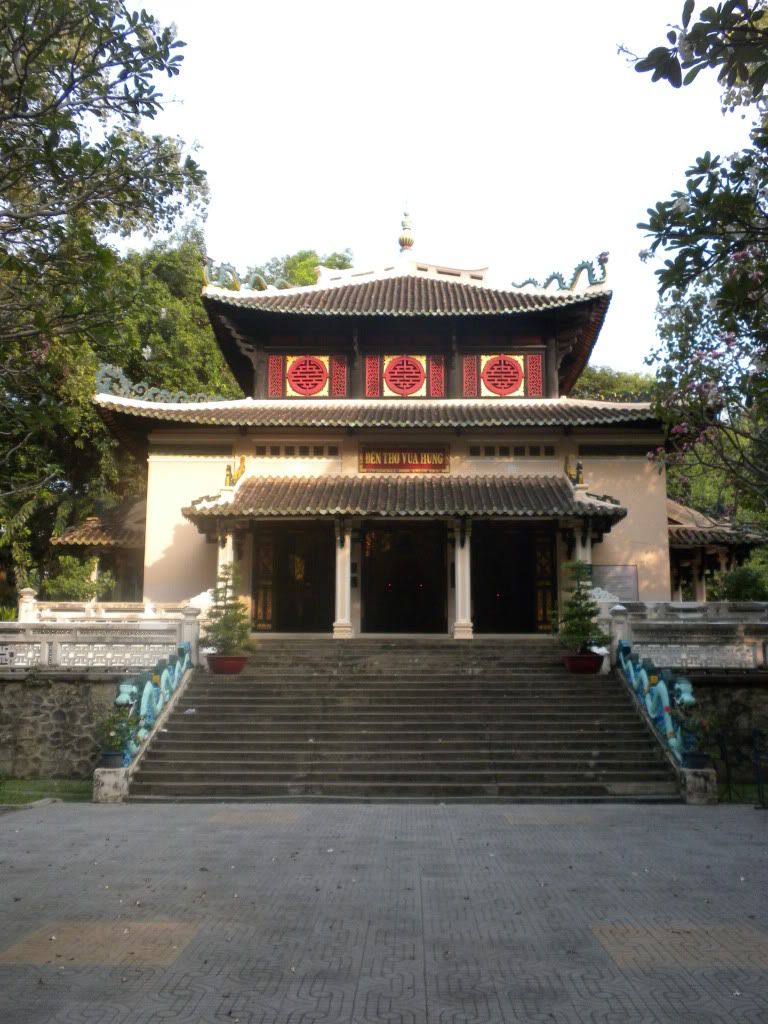
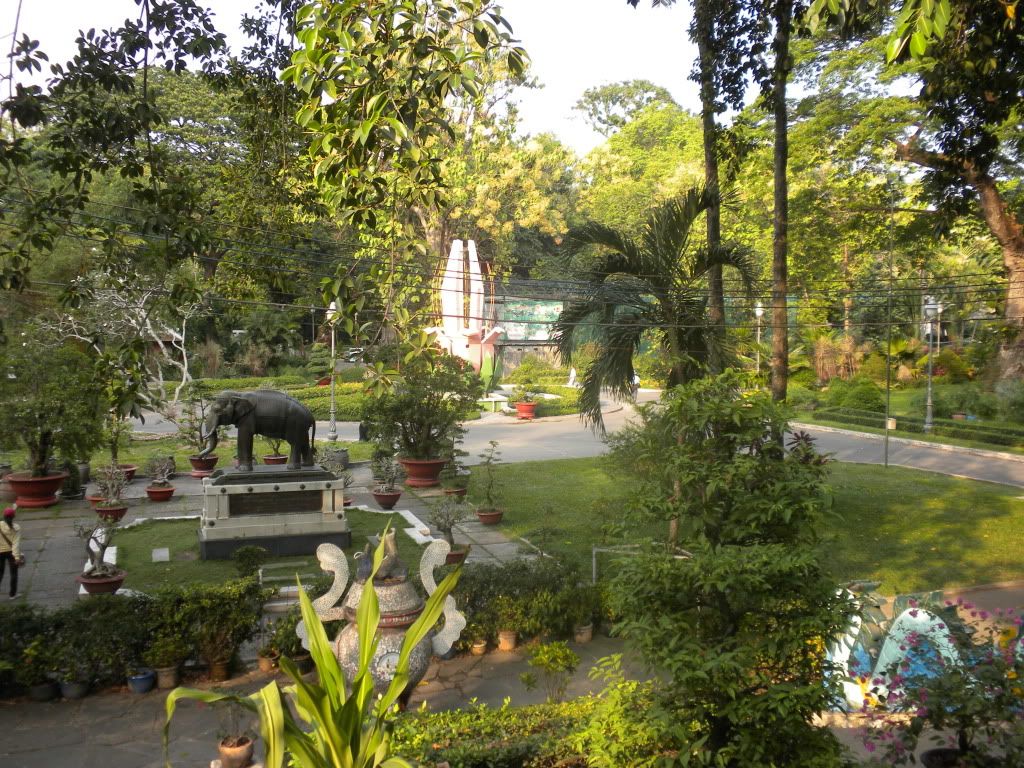
On the 10th of April Francesca and I started the day by booking a day-trip for the following day, as well as the bus ticket to the next city on our list. Francesca wanted to get her nails done, and I wanted to work on our posts for Laos. Whilst Francesca got a fresh paint-job I typed away, and continued doing so for the rest of the afternoon. Lunch came to me in the form of a shared sandwich and free lemon juice, kindly provided by Francesca. In the evening we went out together, getting Francesca a not so healthy meal from the KFC, whilst I got a much healthier (and tastier) tuna salad from next door.
The following day we got up for another free breakfast, after which we got picked up for the tour to the Cu Chi tunnels. The big bus filled up quickly and we felt a little like herded sheep, but since we had paid only a few dollars for the full tour we went with it. Our first stop was a handicraft shop, where we had a look at the impressive creations of victims of the war. What these people can do with broken eggshells is quite amazing!
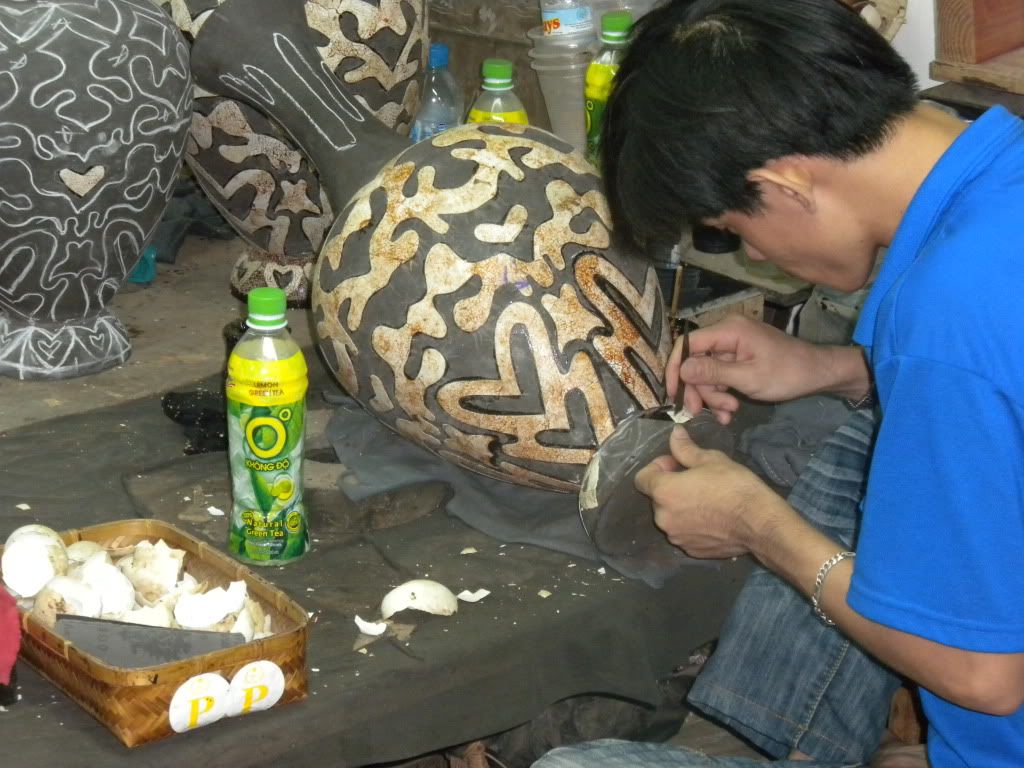
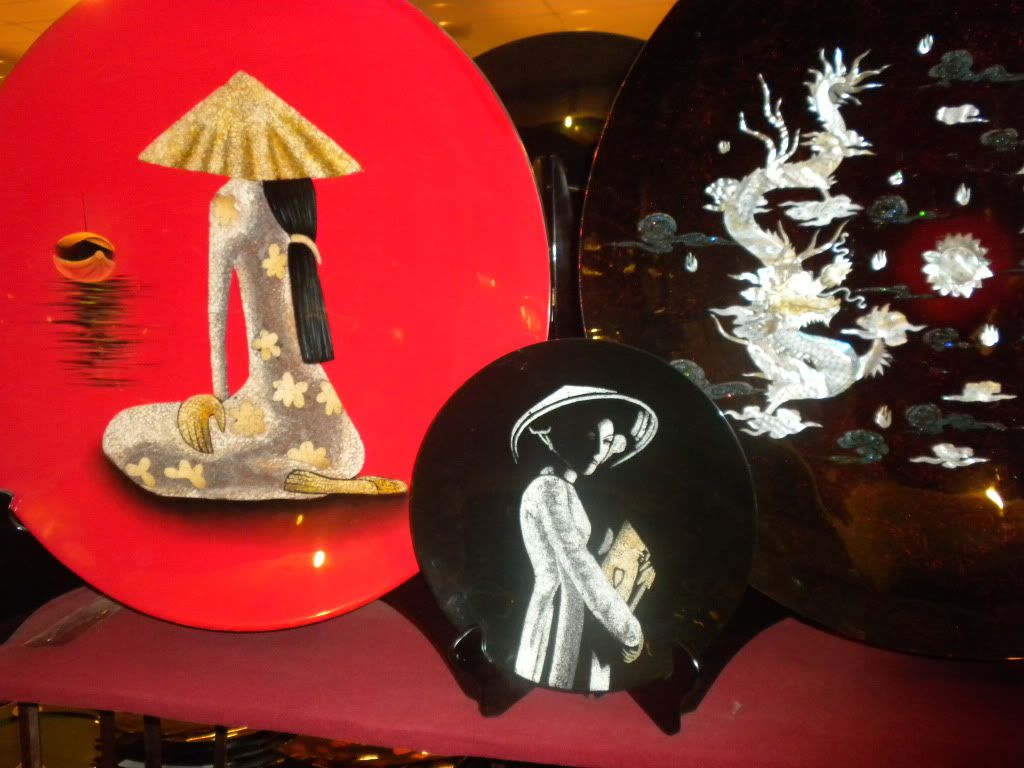
A little later we were back on the bus again headed towards the Cao Dai Temple. Cao Dai is a very interesting religion, officially established in the city of (where we were now in) Tay Ninh in 1926. The term Cao Dai literally means "Kingdom of Heaven." The religion is a mix of Buddhism, Taoism, Confucianism, with Christianity and Islam added in. They also acknowledge Three Saints: Sun Yat-sen (a Chinese revolutionary and political leader), Victor Hugo (a French poet, playwright, novelist, essayist, visual artist, statesman, and human rights activist) and Nguyen Binh Khiem (a Vietnamese administrator, educator, poet, sage). The hierarchy resembles the Roman Catholic Church, and the colors come from a Hindu temple.

From the side we could already see the giant All-Seeing Eyes, peering at us. A few followers, clad in white, were making their way to the temple for noon prayers, which we were to be part of. Before we entered we crossed the street to take a few pictures of a giant obelisk across the street, as well as the front of the temple. Right in front of the entrance stood a few proud old men and women, wearing their prayer-outfits. We learned that most young people don’t have time to pray every 6 hours, so most of the time it’s just the retired oldies that come to the temple. They seemed happy enough to show us their religion and let tourists take as many pictures as they wanted. Francesca and I wondered if their leadership just imposed this on them, or if they had any say in the matter.

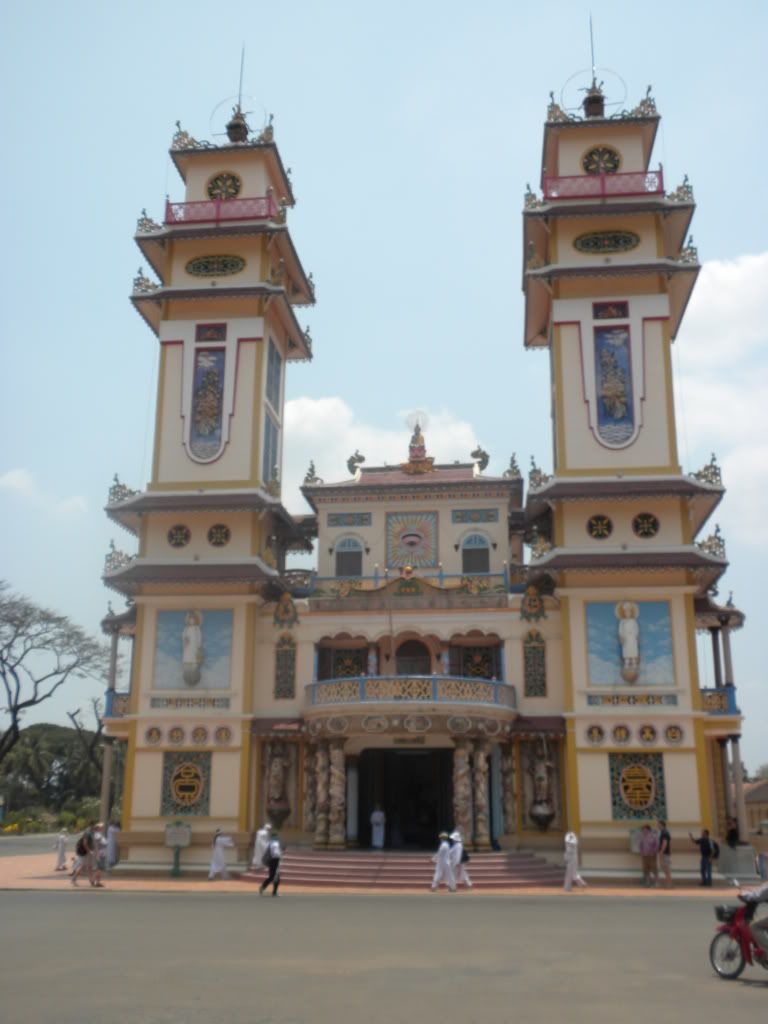
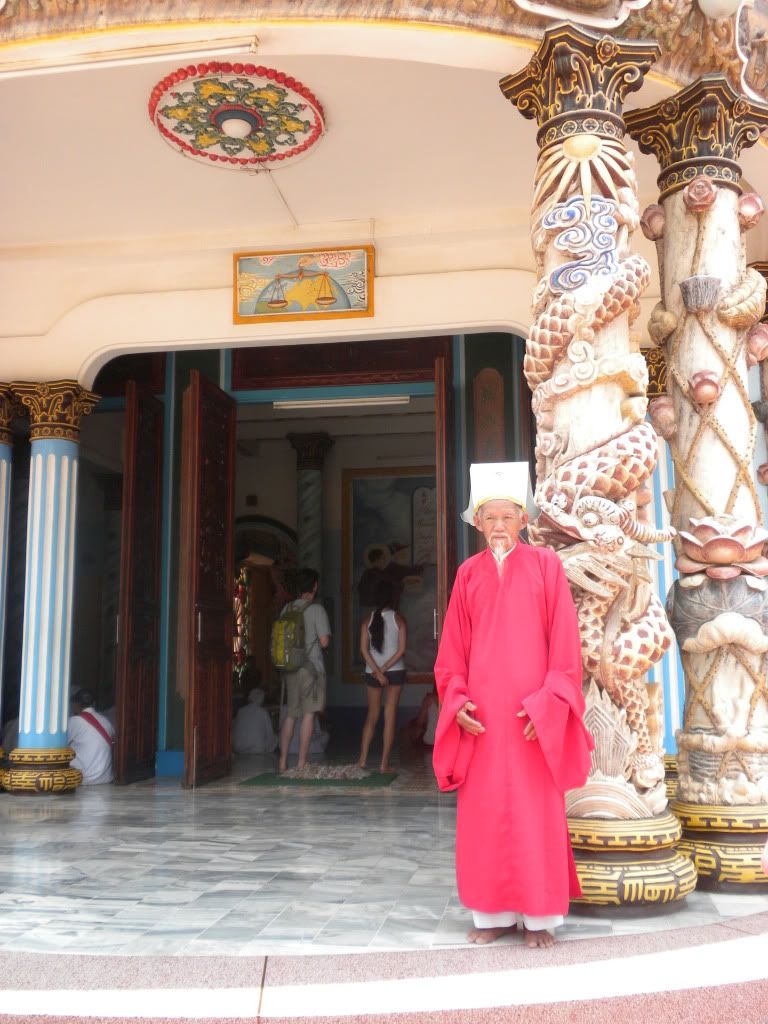
Anyway, we made our way inside the colorful temple and got to have a good look around. The pillars inside were pink, and covered in dragons. Further in the back a green sphere with an All-Seeing Eye seemed to be the main altar, as an old guy in a yellow robe carefully dusted off some artifacts. Then, just after we’d found a good spot on the balcony, at 12:00 AM sharp the followers started streaming in, yellow, red and blue robes first, then followed by the white ones. The different colors of the robes denote different religions, so each is represented through a member of the religion. We watched and listened for a good 15 minutes, before going to the back where the choir was singing. On our way down we spotted the three saints, whose names seemed so random, yet so intriguing to us.
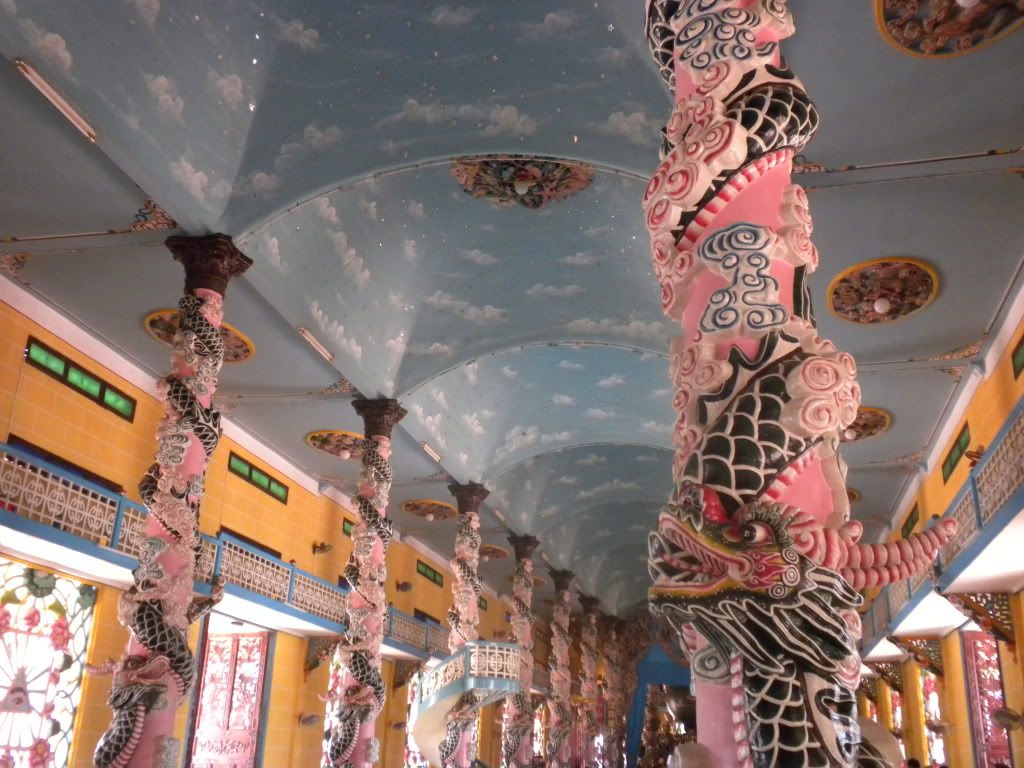
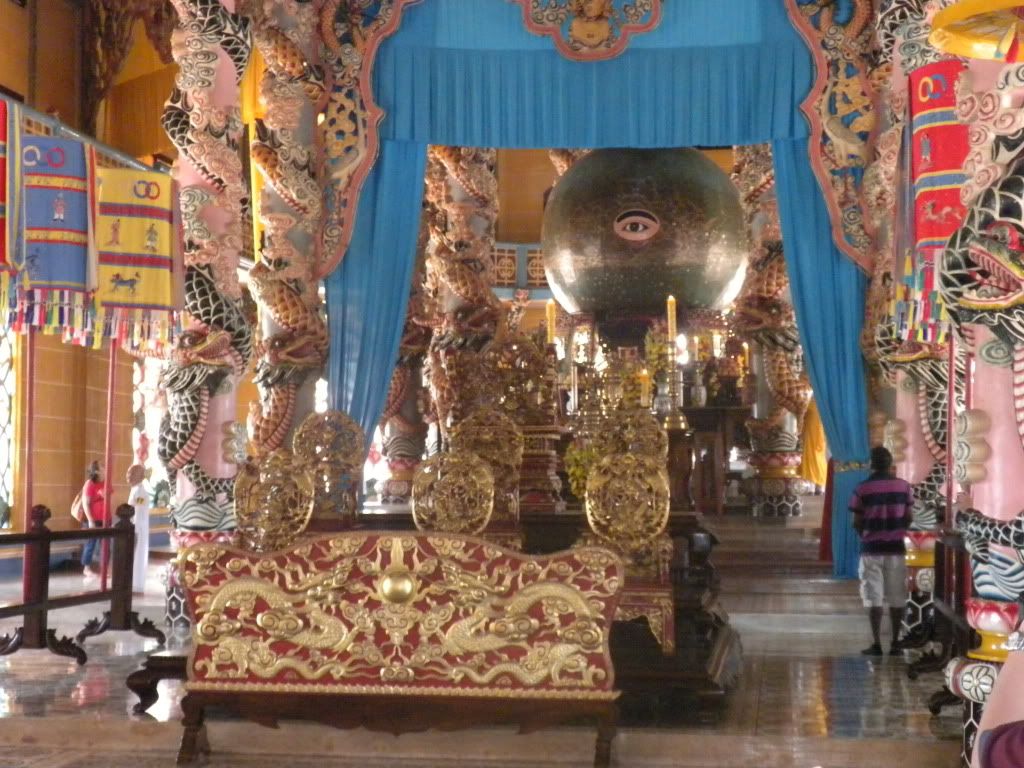

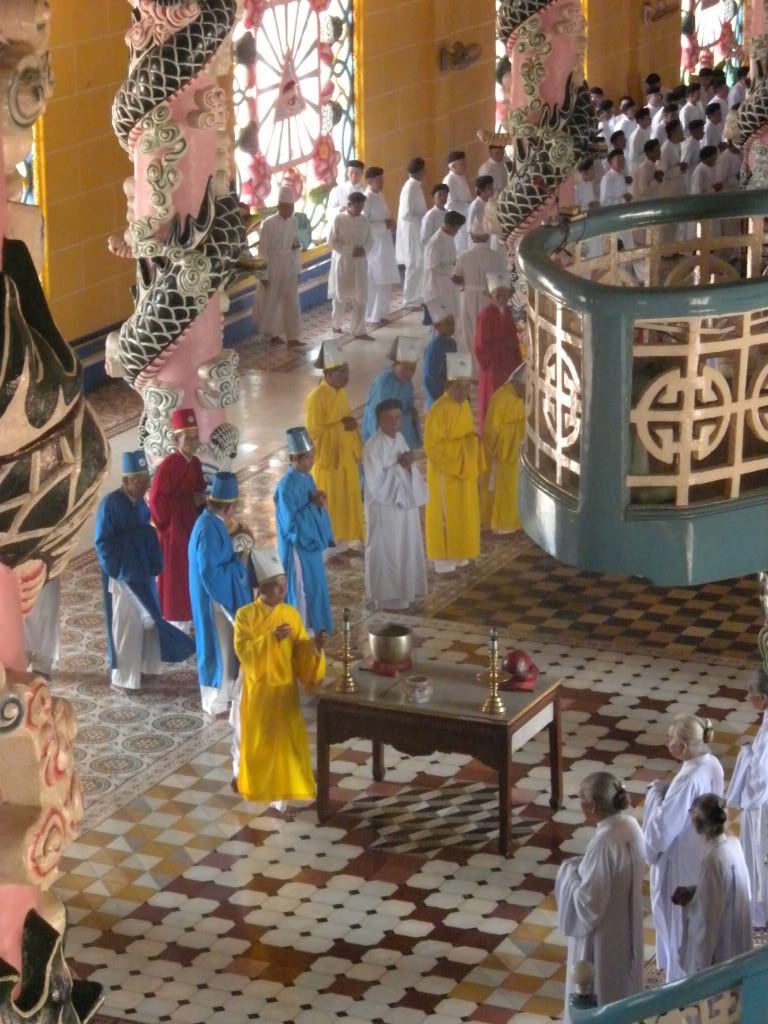
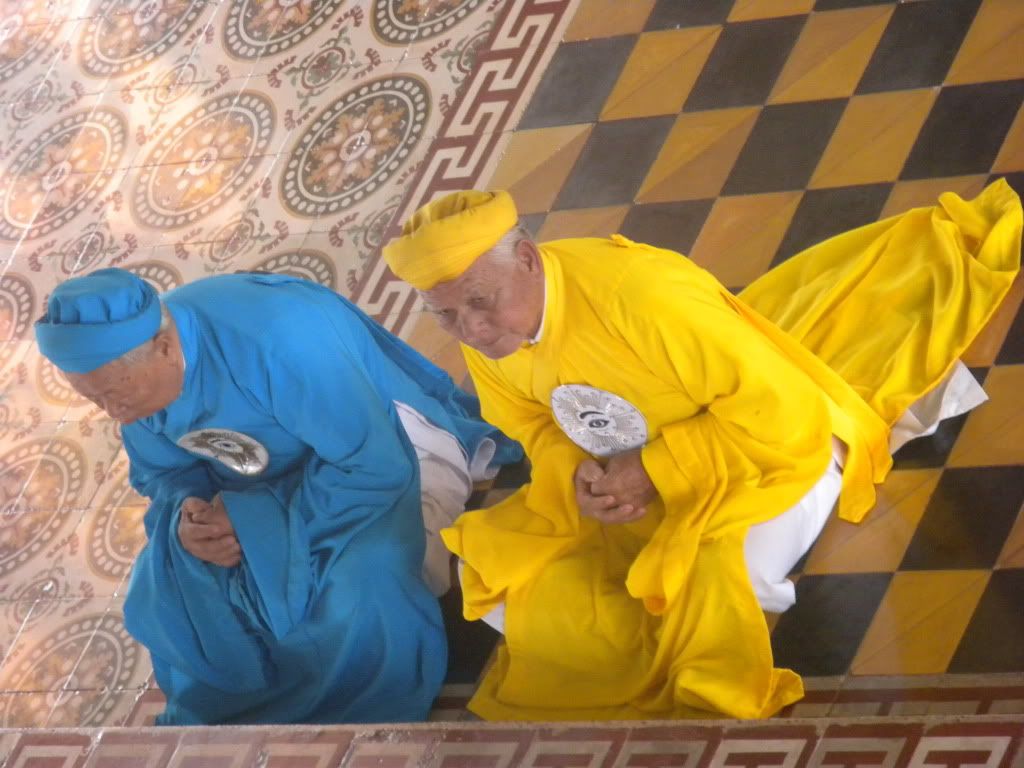
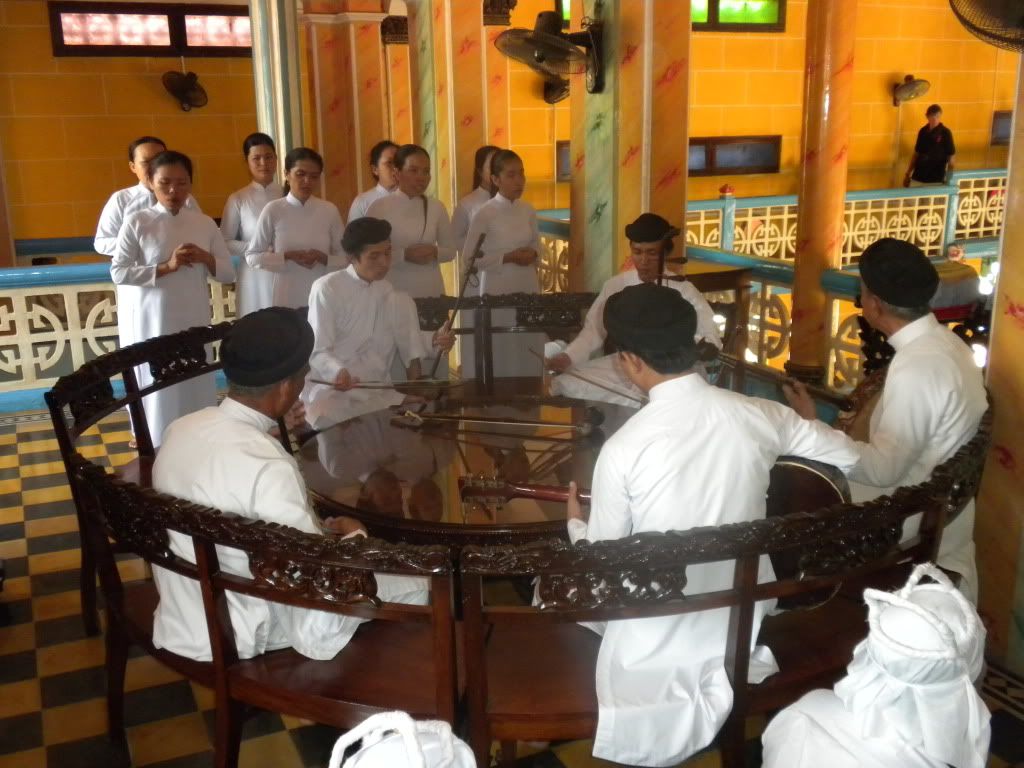
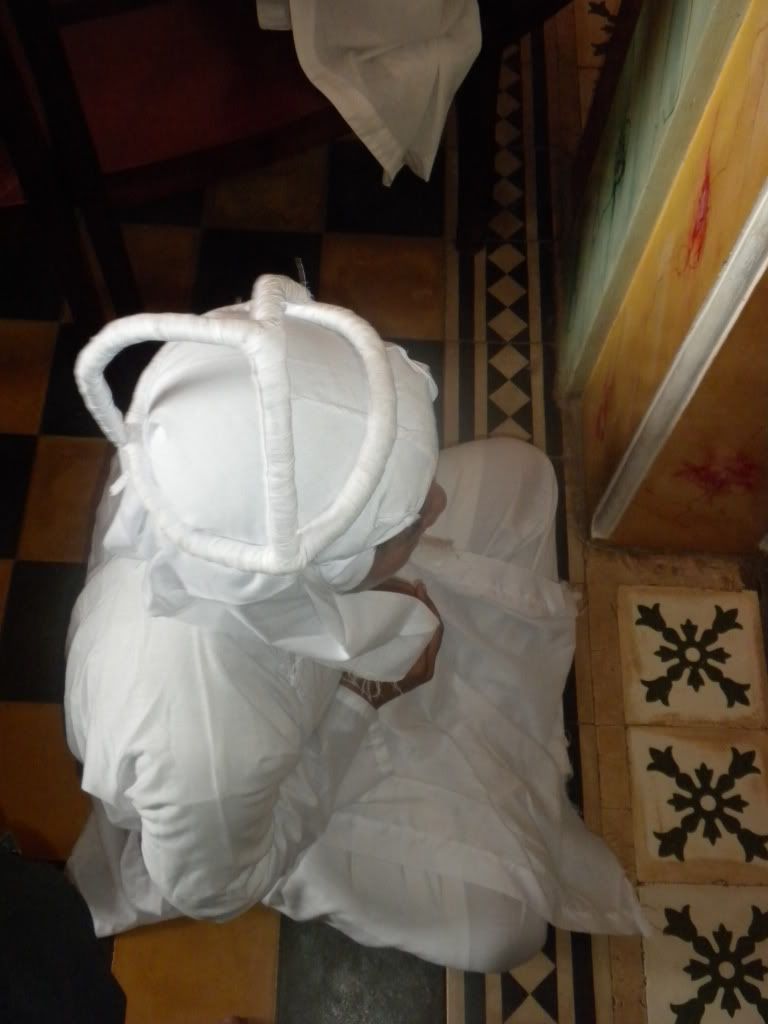
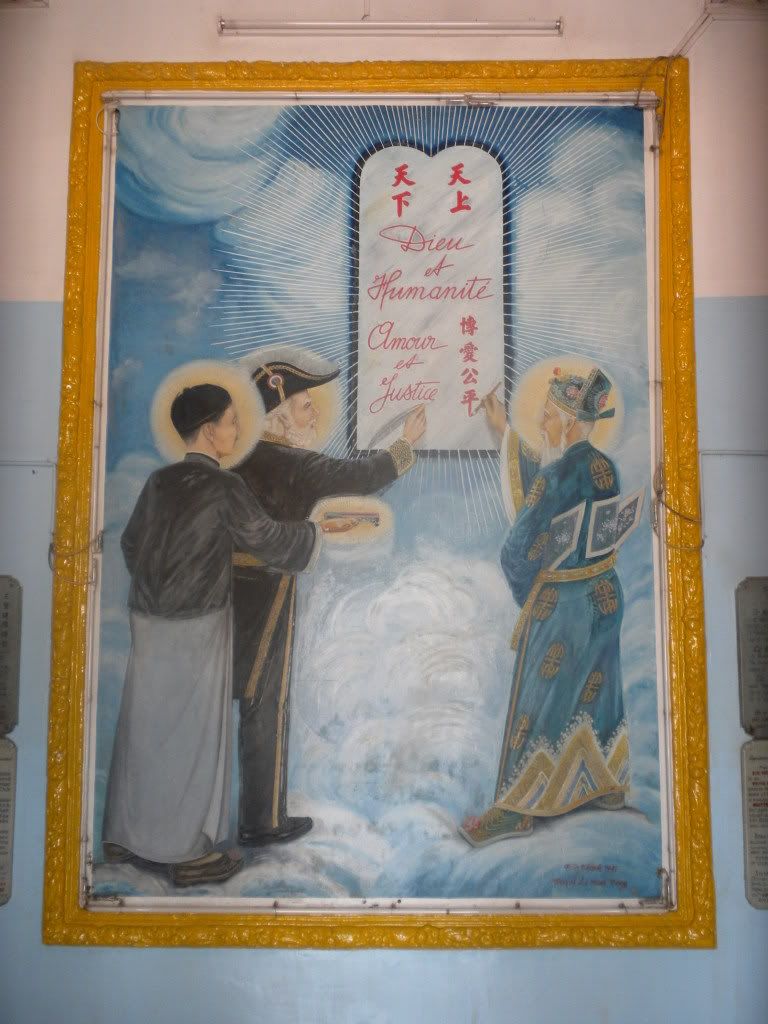
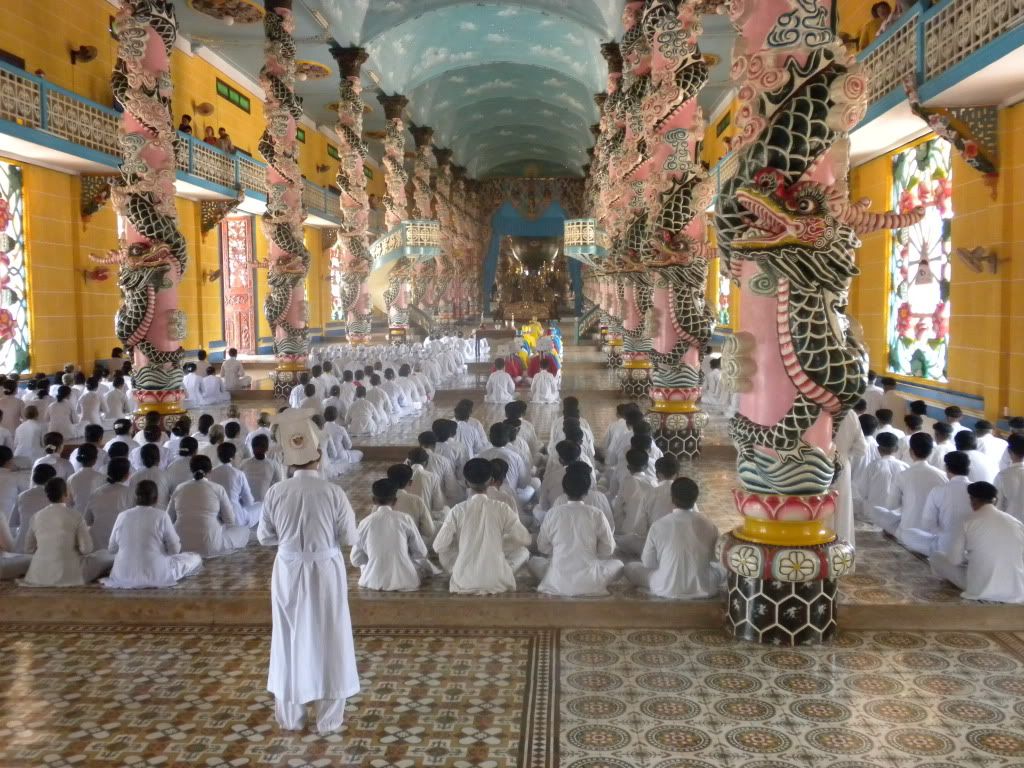
The highlight of the tour followed a short drive (and quick lunch stop) later: the Cu Chi tunnels. From the Wiki: “The tunnels of Cu Chi are an immense network of connecting underground tunnels located in the Cu Chi district of Ho Chi Minh City (Saigon), Vietnam, and are part of a much larger network of tunnels that underlie much of the country. The Cu Chi tunnels were the location of several military campaigns during the Vietnam War, and were the VietCong's base of operations for the Tet Offensive in 1968. The tunnels were used by VietCong guerrillas as hiding spots during combat, as well as serving as communication and supply routes, hospitals, food and weapon caches and living quarters for numerous guerrilla fighters."
Our guide first had us buy tickets, after which we were led into the forest. He stopped at a seemingly random spot, where he asked us if we saw a way for a VietCong member to escape. We saw none, so he wiped away some leaves off the forest floor, and uncovered a tiny lid. He took the lid off and climbed in, disappearing entirely. Of course I had Francesca jump in to take some pictures of her! It was amazing to see how fast and easy one soldier could just disappear off the face of the earth. We realized how hard it must have been for the Americans to fight these people.
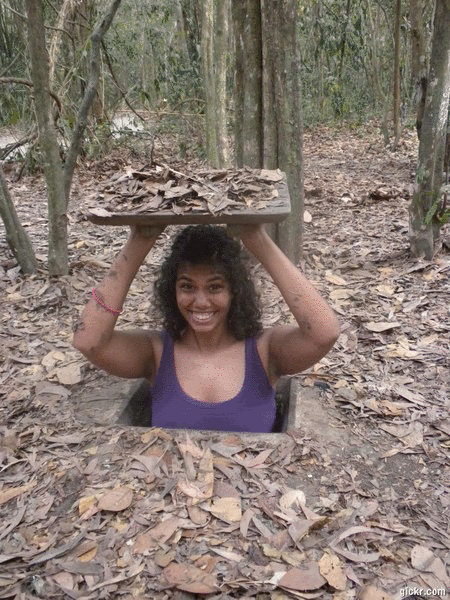
Next, we were shown a spike trap, which the VC used to either kill or maim Americans. They knew Americans wouldn’t leave a wounded comrade behind, and they actually hoped they could slow their troops down. We were also shown some VC in traditional outfits, including traditional scarves. A larger variety of traps followed, and the horrific damage the sticking trap (a trap that is triggered by weight, shooting metal pins into the leg of the victim), the armpit trap (a trap that sucks the victim in and hits him high in the body), the rolling trap (with traps that circle around an axle, causing multiple wounds) and finally the hanging trap (set in a door to go off when opened) could do to human bodies proved the VC’s inventiveness and effectiveness.
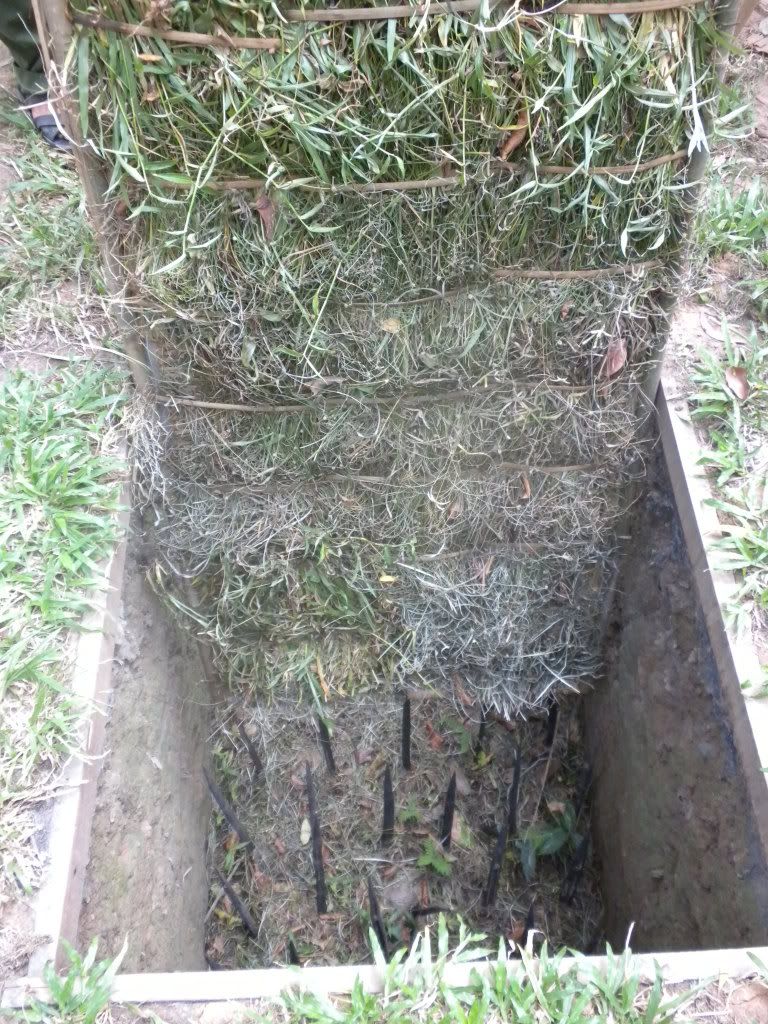
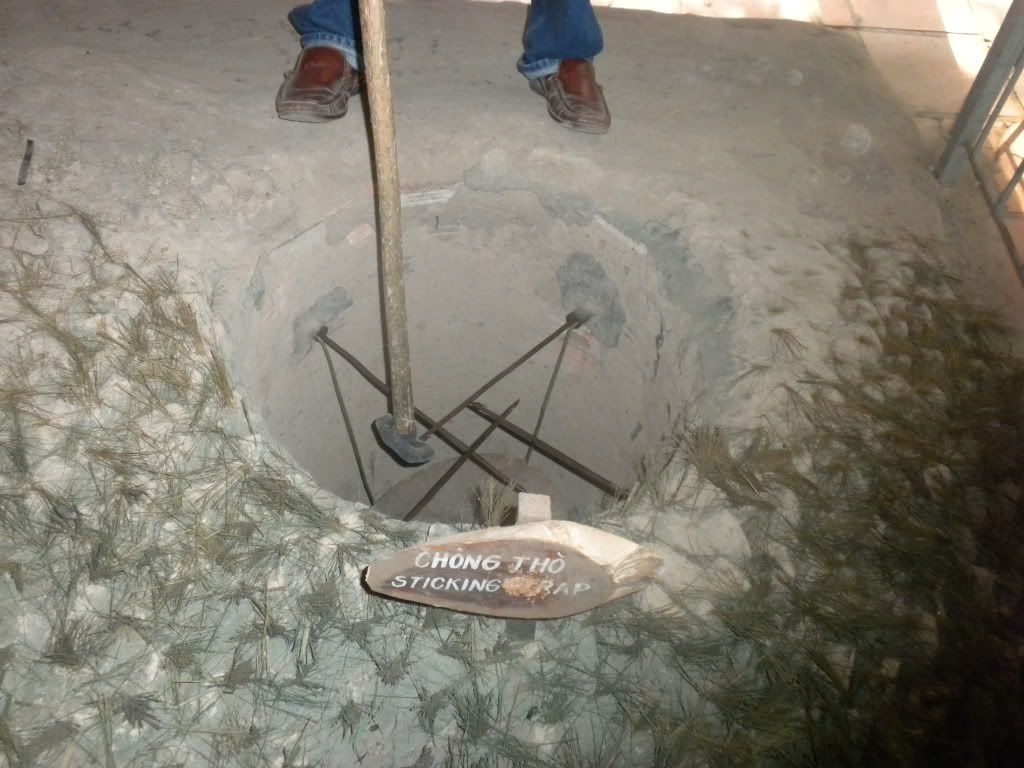

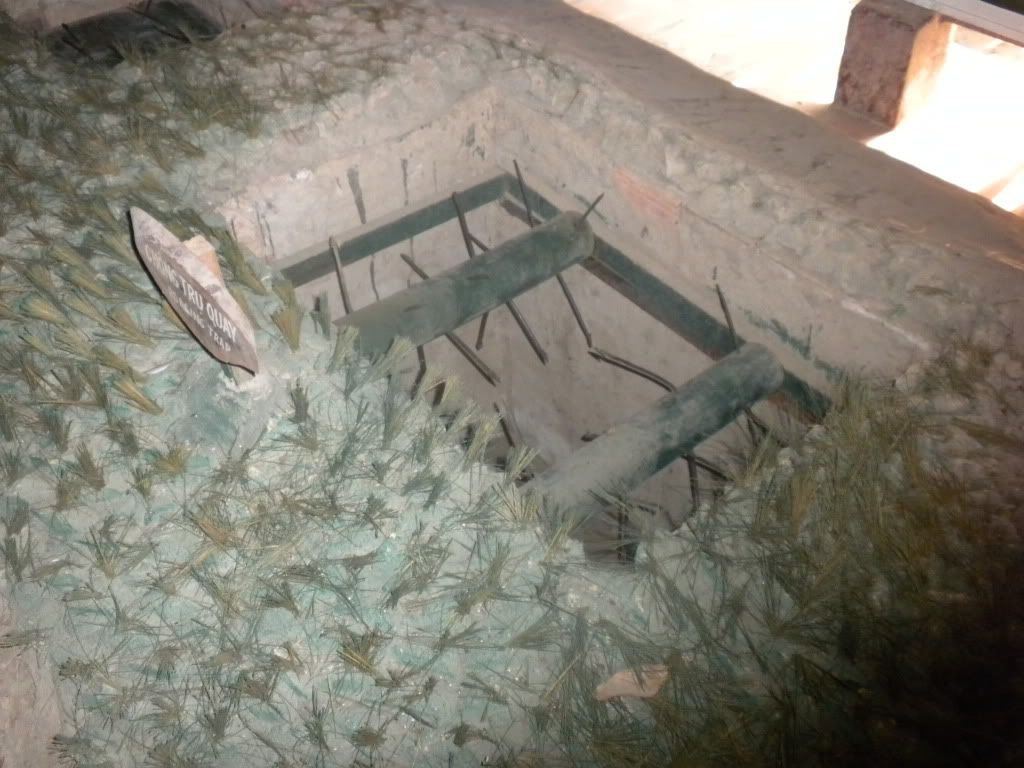
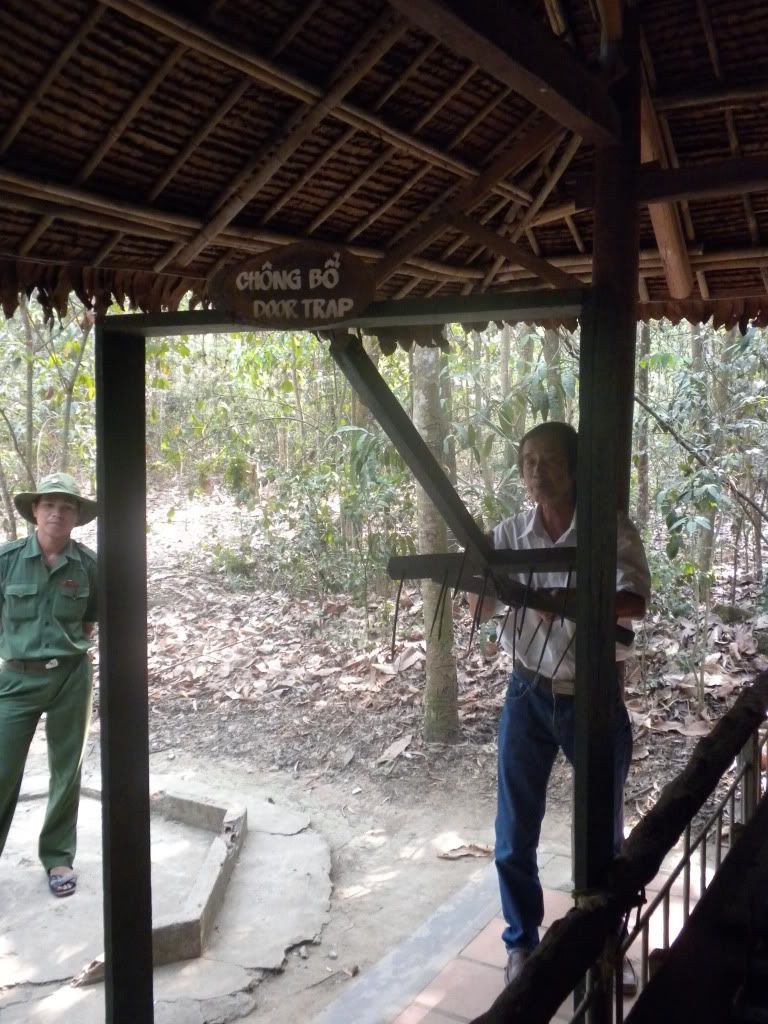
Next, we got a look at some traditional scenes out of the life of VC: making weaponry, bombs and traps. Actual human beings were making sandals out of tires. The sandals gained much fame during the war as they were practically indestructible. We passed up on the chance to buy some, instead following our guide as closely as possible to be the first ones in the tunnels. It looked small for Francesca as she crouched in, and I knew I’d be in for a rough ride. It was amazing to hear that these tunnels were actually enlarged for tourists! It got pretty hot inside, but we crawled all the way through to the end, part of a select group of non-claustrophobic travelers. When we did finally emerge we were covered in sweat and dirt.
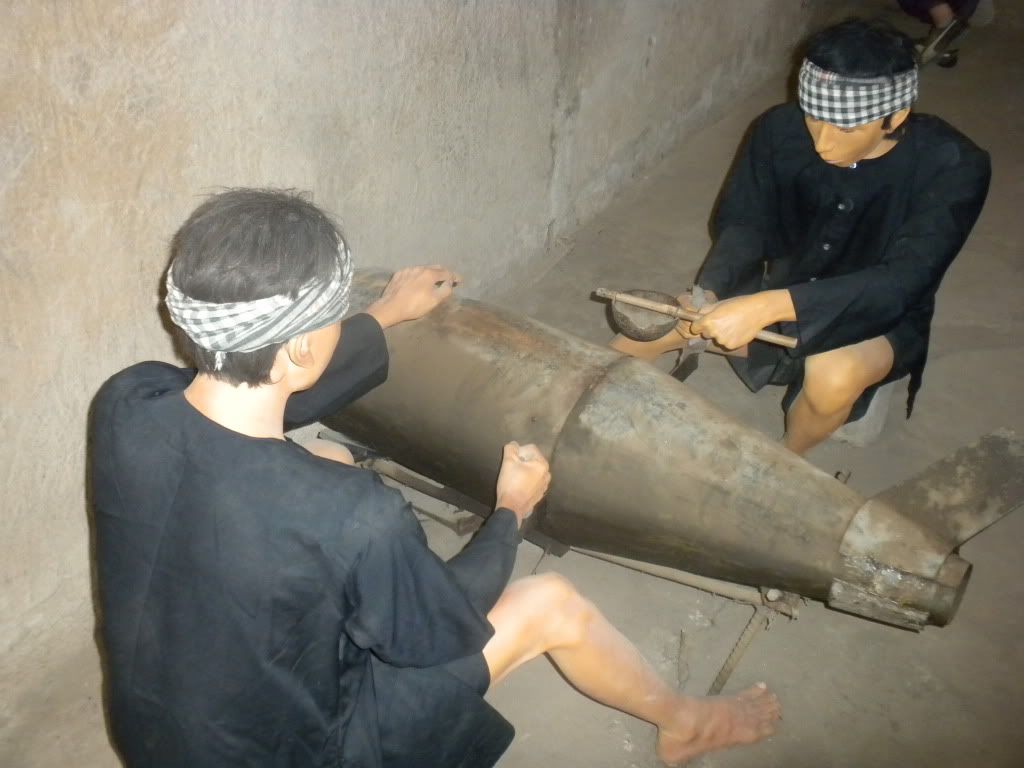
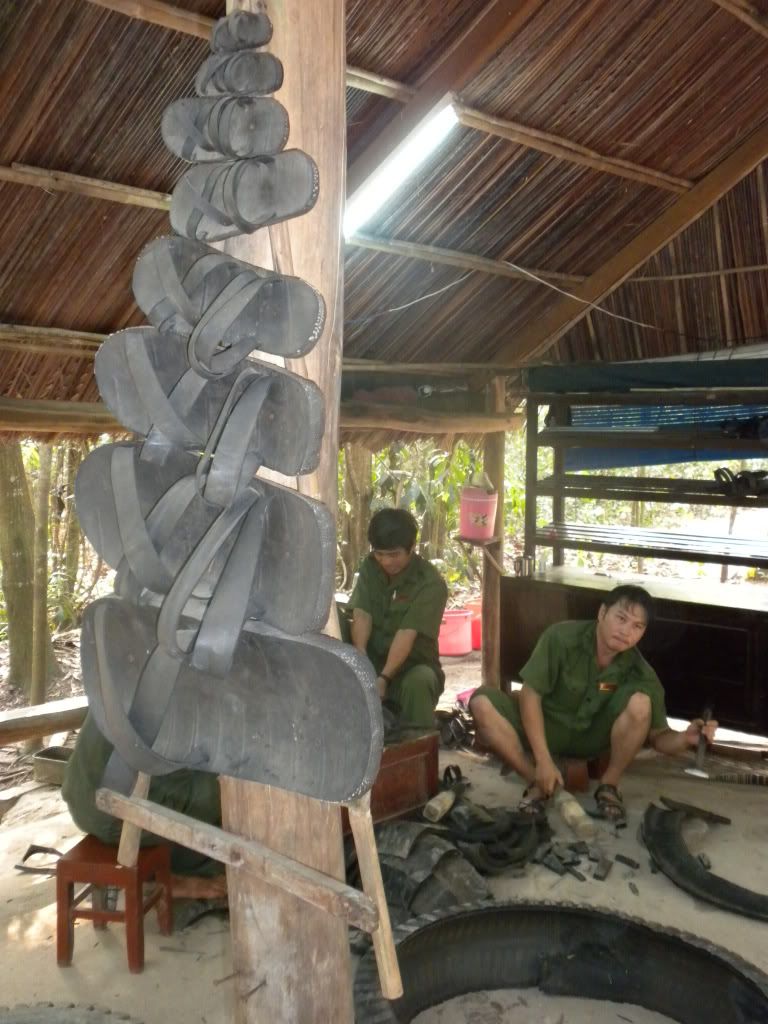
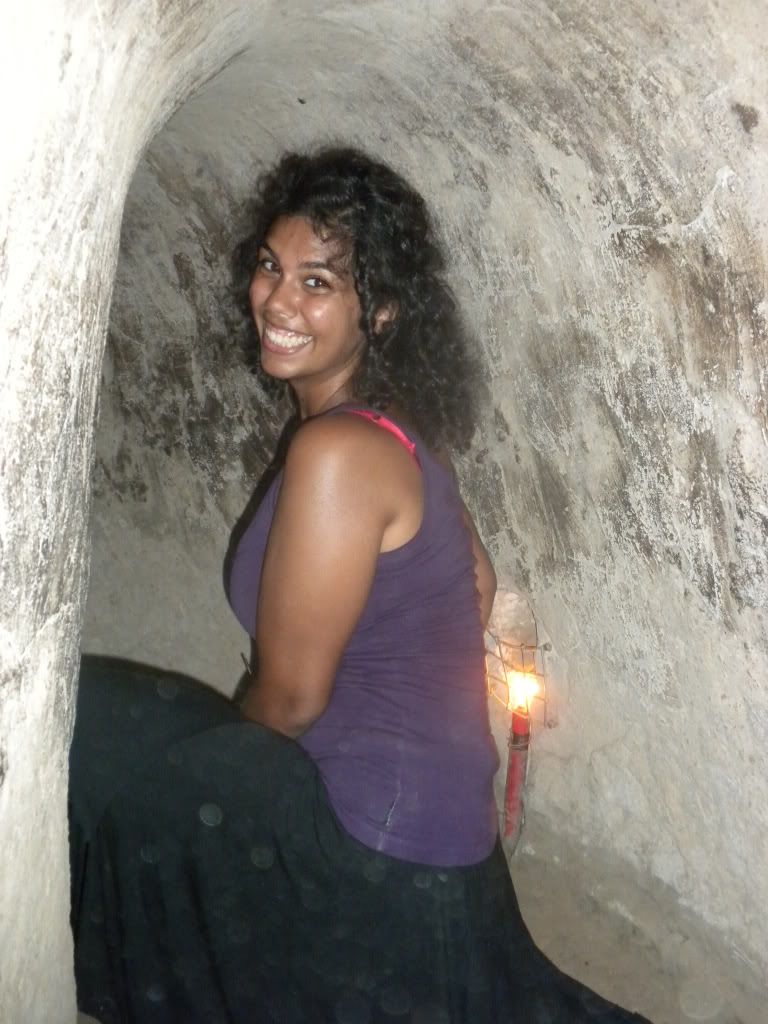
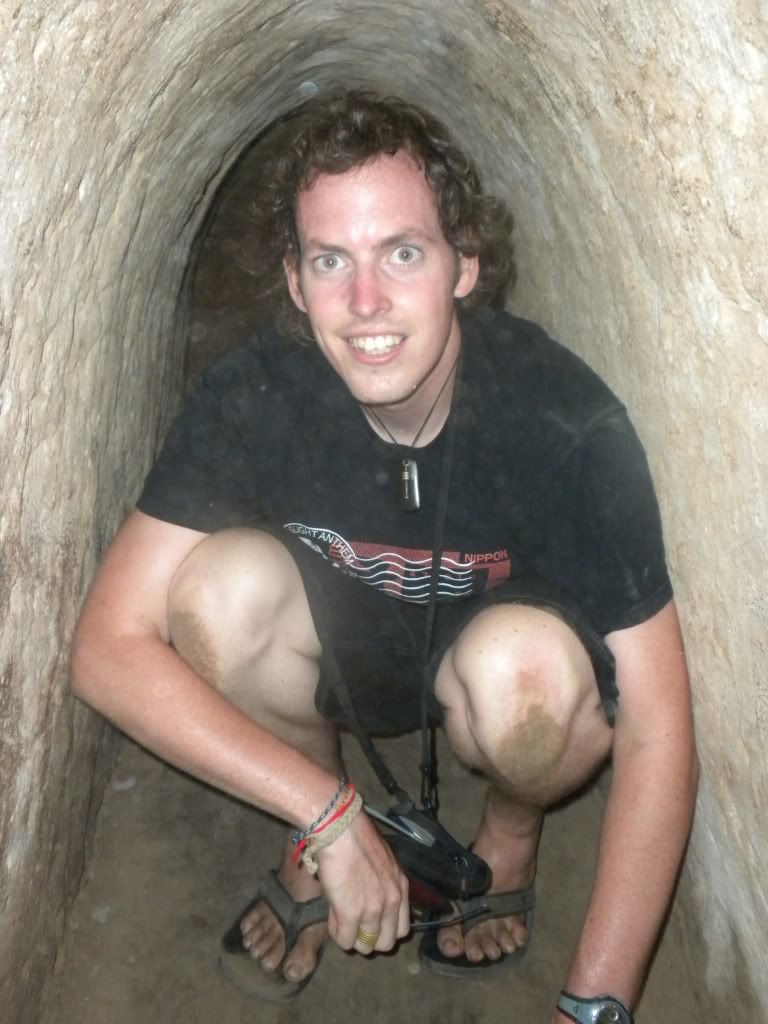
SCARY!
Dirt and sweat brushed off, Francesca and I had a look at the shooting range where we had the chance to spend a few bucks on using an AK-47 or heavier weaponry. However, the guns were mounted and they were not cheap. Furthermore, we’d heard of other shooting ranges where you’d get to hold the guns yourself, where you could shoot bazookas, and even blow up a whole chicken or cow! Next we had a short break and got to try some VC specialties: tapioca with a crushed peanut dip and green tea.
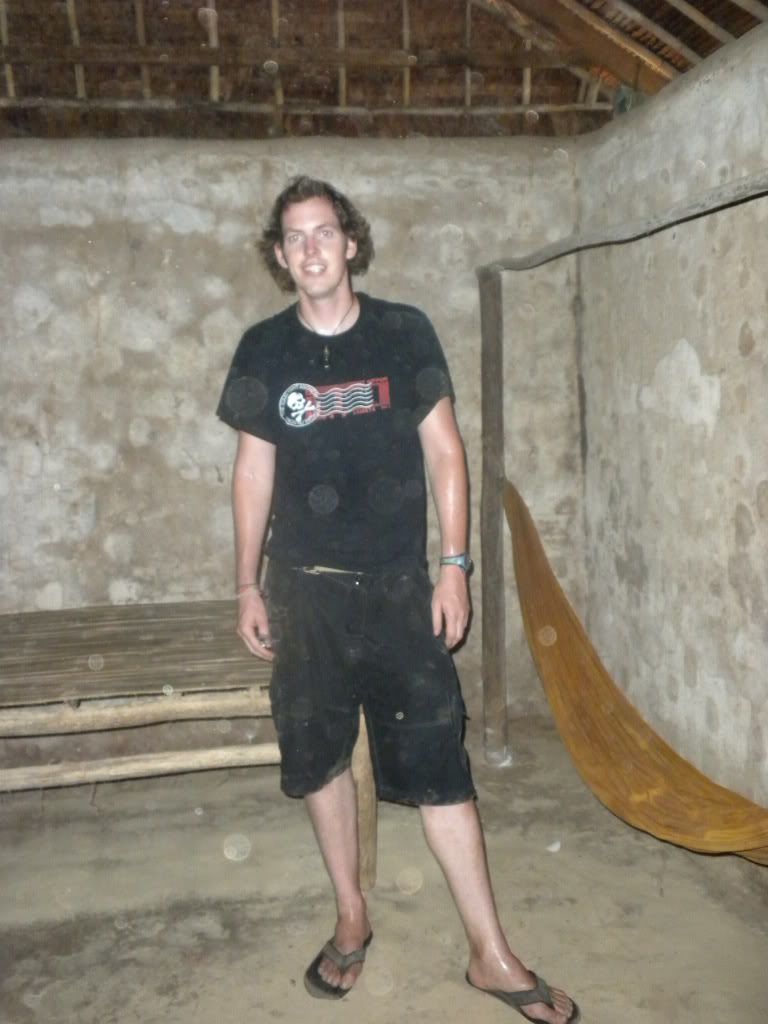
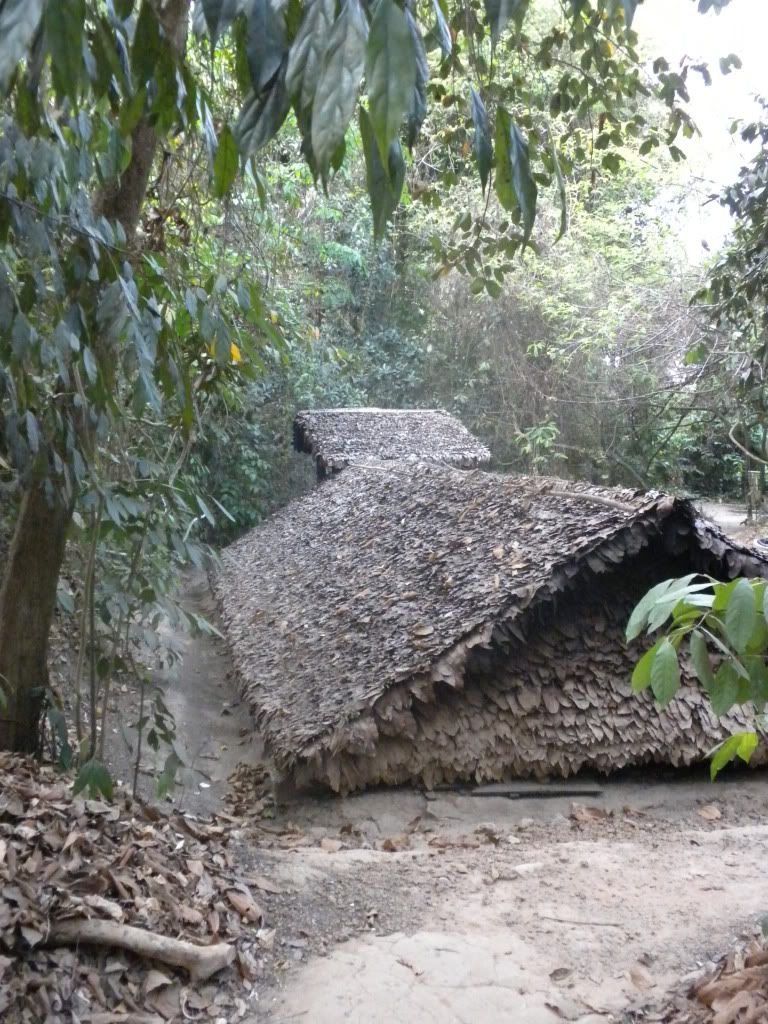
We got to see a short propaganda video about the lives of the locals as well as a diorama of the tunnels. Our guide used the map on the wall to explain a bit more about the tunnel paths in the area. Turns out a VC could enter a tunnel in the thick of the jungle and exit out in the sea... seeming to completely disappear to their enemy! This concluded our tour. We were taken back to the city, where Francesca and I rested up and ate a chicken-burger and fish-and-chips dinner at Bobby Brewers later that evening while watching part of the strange movie 'The Defendor' about a Don Quixote-esque guy who thinks he is a superhero.
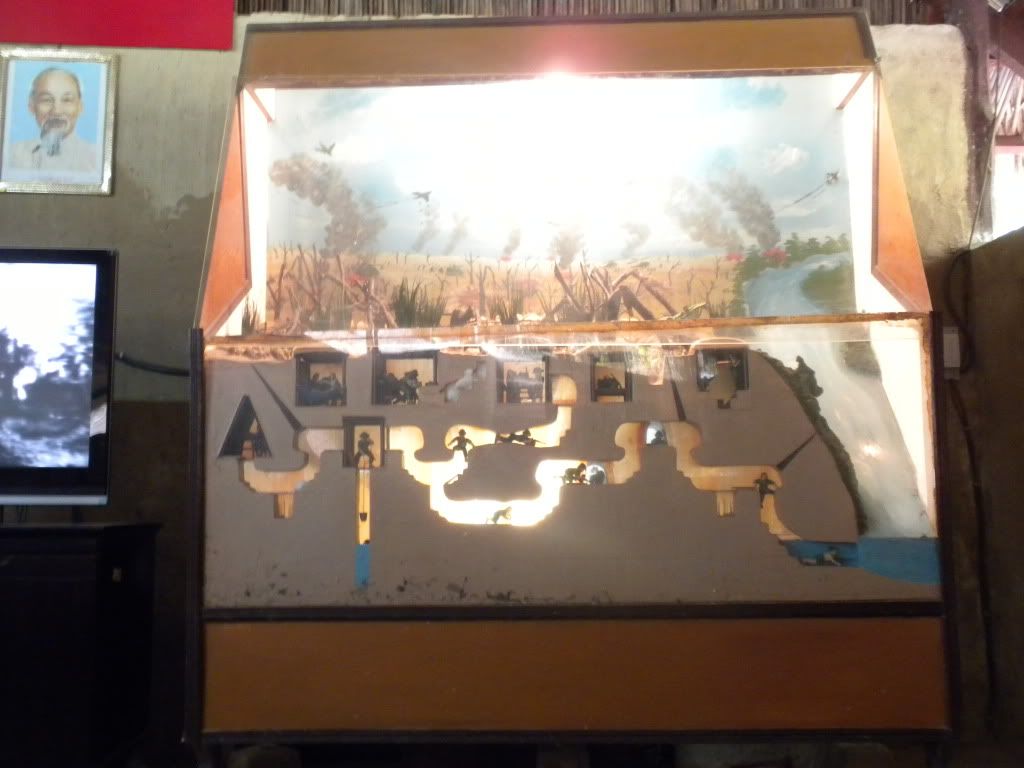
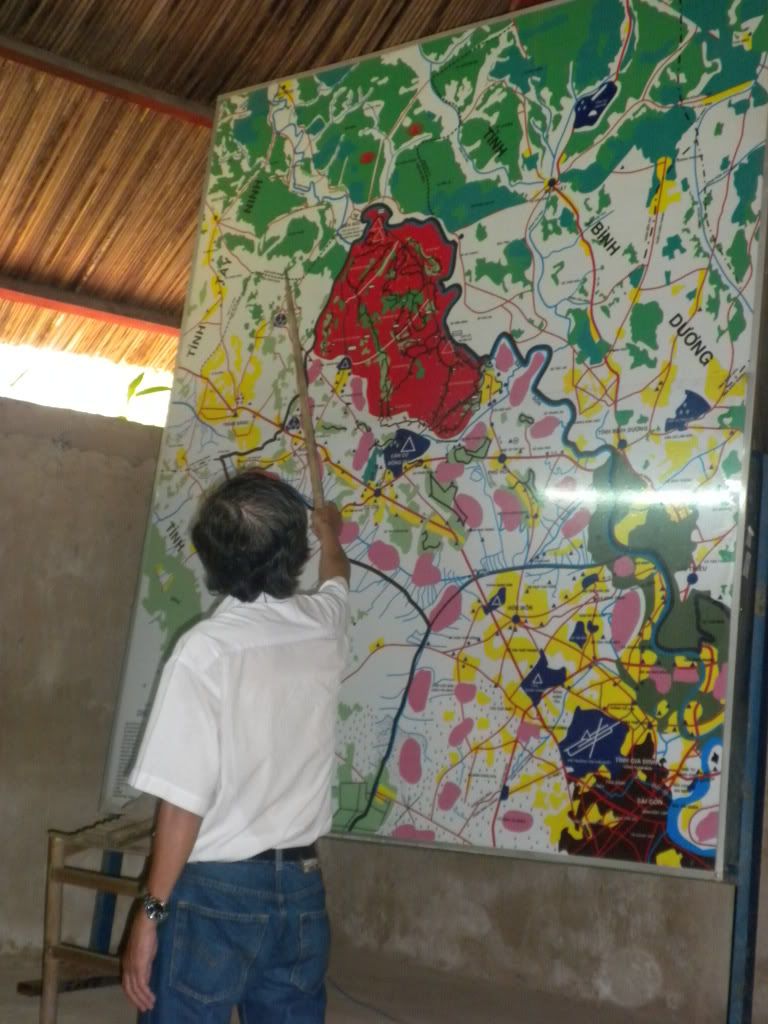
We didn’t have much planned for the 12th other than leaving HCMC and only exited our room for lunch. We had wanted to get Uncle Randy his Hard Rock Pin, so we looked up the address for the Hard Rock Café. We were surprised to find we’d already walked past it once. When we popped out of the taxi at the Kumho Asiana Plaza we realized we’d missed the Café because it was inside the large, new mall. We ordered a huge burger each and felt good eating our tasty meals. We left the HRC around 2:00 PM, Francesca with Uncle Randy’s new Pin in hand. We headed for the War Remnants Museum one last time, hoping to finally catch the documentary. I got us in for free, but now the movie room had turned into a shop. No luck for us!
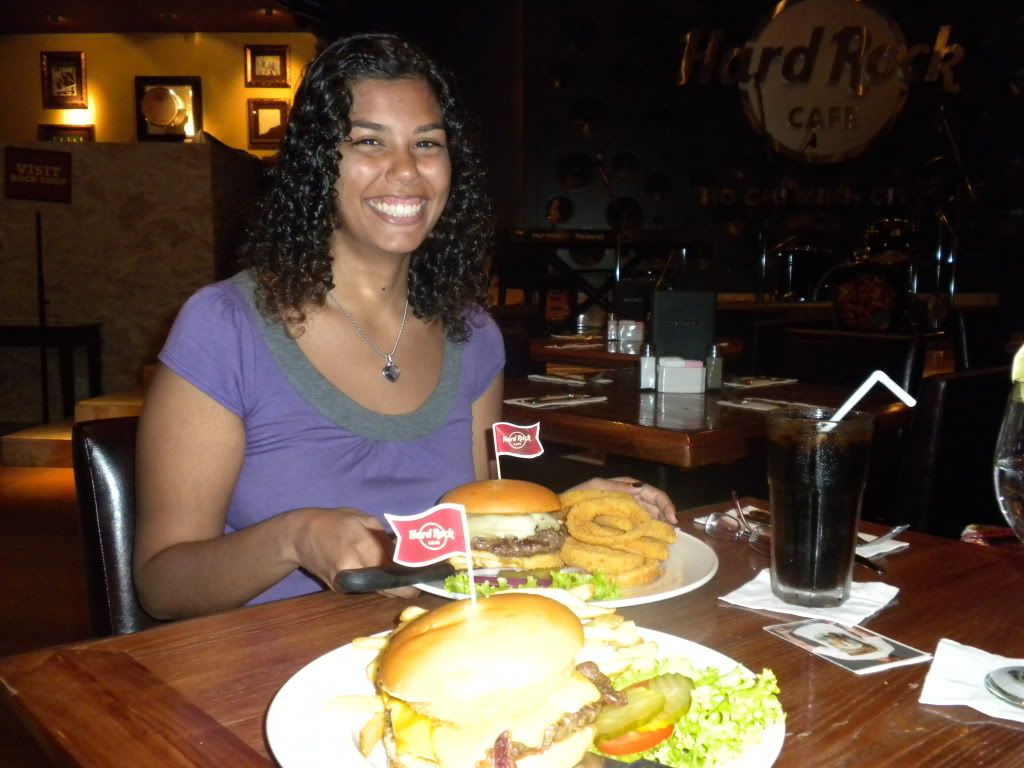
We had booked a sleeper bus for later that day, so we decided to spend the whole time at Bobby Brewer’s. We watched part of 'Lord of the Rings,' as well as a second attempt at Woody Harrelson’s 'The Defendor,' finishing the night with Tim Allen's 'Crazy on the Outside' about an ex-con painter who falls in love with his parole officer. Talk about strange movies! Time flew by and before we knew it we were back at the Me Them where I carried the bags over to the bus. Unfortunately we didn’t get double sleepers this time… The single beds were a little too small for me, and since we were in the back of the bus we felt the suspension (or lack thereof) more than the last time. Nonetheless we both slept!


Our guide took us around and showed us ancient textbooks written by medicine men of many ages ago. Next, he showed us an altar with the statues of two of Vietnam’s most famous medical progenitors, Tue Tinh and Hai Thuong Lan Ong. The small piece is engraved with Chinese characters and scrolls, signifying the Chinese influence on healing techniques, as well as the overarching importance of China in Vietnamese daily life. An interesting difference between Vietnamese (and Eastern) healing and Western techniques lies in each technique's approach: the Western doctor will find what’s wrong with you (the problem) and fix that – the Eastern medicine man will find the cause of what’s wrong with you (the ROOT of the problem) and help you fix that. This small yet vital difference has seen the latter approach soar in popularity as Westerners and locals alike go to two newly founded schools that specialize in teaching ancient methods of healing.



As we walked through the different floors we saw a large collection (over 3000 pieces!) of many different items once used by medicine men: knives, pestles and mortars, pots, medicine jars, scales, cabinets, printing molds, spirit gourds, and tea pots, just to name a few. Also interesting was the large amount of paintings and carvings on the walls. Most interesting was a wooden artwork depicting a large tree, on which the names of 100 well-known doctors from the 7th to 20th centuries are written. These physicians are credited with significantly contributing to the country’s development of medicine.




Francesca had found a description of the museum online and had been enticed by the promise of being able to try some medicine making on the premises. And indeed, one of the rooms was completely decorated as a medicine shop. The walls were lined with jars, stuffed with all sorts of ingredients. We put on traditional outfits and then ground powdered medicine using ancient machines operated by our feet or hands. We also took turns standing behind the counter, pretending to weigh or sell goods.






The tour ended with a video presentation about traditional medicine in the modern world. It showed how the ancient techniques still hold validity in this increasingly technocratic era. We were impressed by the accurate ways patients are diagnosed – not with MRIs, but by deciding their energy level and taste, listening and observing carefully, finding a cure that way. We got a cup of traditional healing tea before we left, and I bought some mushroom-based medicine which is supposed to raise your energy-levels and help you fight off common colds. Let’s see if it works!
Francesca and I decided to find a renowned pagoda nearby, and with the directions of the guide in my head we had no problem finding the Chinese Phuoc Dien temple. The large statues inside were impressive, but we were still 'watted-out' and left after a few pictures. Instead, we took a taxi to the Reunification Palace and walked to Window’s, a bar/restaurant we had seen the day before. We sat down at a hip table in the back, music blaring loudly from the speakers as TVs all around us showed a wide variety of shows. Francesca treated herself to a small cheese pizza, whilst I got a large salmon salad and a peach ice tea. The food tasted good, but the music got to us a little. It made us leave right after finishing our plates.


We wanted to finish our exploration of the War Remnants Museum, thus it became our next stop. Francesca and I were hoping to catch the documentary we had missed the day before, but when we got to the room it was supposed to be in, it had been emptied out and we heard construction had been planned. No documentary for us. Not that much of a problem, since we still had quite a lot of exploring to do. Francesca already told you about Agent Orange, so I will share with you some of the other stories we read about at the museum.
The first floor, besides showing the atrocious pictures of Agent Orange and napalm victims (that Francesca told you about), also housed photos of other war crimes committed by American troops. We saw them throwing prisoners out of helicopters, kicking helpless civilians and proudly standing around with the remains of a shredded Vietnamese man. Pictures of victims of napalm-bombings also left little to the imagination. Thoroughly impressed and slightly nauseated Francesca and I entered a room that showed elementary school drawings with world peace as the topic. Some also dealt with the war. I found a definite favorite in the depiction of Agent Orange victims.





Francesca and I headed upstairs, where we got a thorough history lesson about the Vietnam War. I’ll summarize quickly with Wikipedia’s help:
"The United States entered the war to prevent a communist takeover of South Vietnam as part of their wider strategy of containment. Military advisors arrived beginning in 1950. U.S. involvement escalated in the early 1960s, with U.S. troop levels tripling in 1961 and tripling again in 1962. U.S. combat units were deployed beginning in 1965. Operations spanned borders, with Laos and Cambodia heavily bombed. Involvement peaked in 1968 at the time of the Tet Offensive. After this, U.S. ground forces were withdrawn as part of a policy called Vietnamization. Despite the Paris Peace Accords, signed by all parties in January 1973, fighting continued.
The Case-Church Amendment, passed by the U.S. Congress in response to the anti-war movement, prohibited direct U.S. military involvement without congressional authorization after August 15, 1973. U.S. military and economic aid continued until 1975. The capture of Saigon by North Vietnamese army in April 1975 marked the end of Vietnam War. North and South Vietnam were reunified the following year.
The war exacted a huge human cost in terms of fatalities, including 3 to 4 million Vietnamese from both sides, 1.5 to 2 million Laotians and Cambodians, and 58,159 U.S. soldiers. By this war's end, the Vietnamese had been fighting foreign involvement or occupation in various wars for over a hundred years."
Throughout our trip in Vietnam we’ll learn more about the war and we will describe events in more detail as we reach the sites where they took place.
The following room showed impressive paintings by local artists. Another portrayed the war through the eyes of two Japanese photographers. The black and white pictures gave another face to the war, closely dealing with the soldiers’ lives on the front. It was very intriguing to study the faces of the young boys, thrown into a war with no idea what to expect. Yet another room showed how the world finally caught on to the horrors of the war, as suddenly protests ensued all over the globe. Posters from many different countries depicted the saddened faces of poor Vietnamese children, begging for the war to end.

As my little summary explained, the war wasn’t just between the Americans and the Vietnamese. The North fought the South as Communism and Capitalism went head to head. Prisoners of War were taken on both sides. Outside the museum we saw a remake of two typical prisons of the time, the Con Dao and the Phu Quoc jail and all the breaches of the Geneva-convention that came with them. Phu Quoc was known as a “Political Correctness Camp,” where in reality over 4000 prisoners died of torture.
The pictures we saw, once again, had us shivering. We saw images of skin-over-bone men with heavily mutilated limbs. We saw pictures of skulls with 3-4 inch long nails driven into them, once belonging to living human beings. We read about horrible torture techniques, such as nails being pulled out and acid being poured on, teeth being smashed, burned sex organs and mouths, broken bones and prisoners being boiled alive. There seemed no end to the cruelties. The “Tiger Cages” were yet another infamous punishment: a tiny cell measuring no more than 2.7m by 1.5m by 3m was filled with up to 14 prisoners during summer time. The heat got so intense they had to take turns taking fresh breaths of air. The guards poked at them with sharp sticks, beating them when they so much as moved. Food was scarce, and water equally hard to come by. Death rate in the “Tiger Cages” was insanely high. Another version of the “Tiger Cage” was an open air variation, made of barbed wire. The cage was so low from the ground that standing was impossible. The sun burning all day long made the experience worse, and combined with guards harassing prisoners from all sides made this another death trap. We saw pictures of survivors and could not possibly imagine the pain they’d gone through.




We left the prison section and ended up looking at several helicopters, fighter jets, tanks and large artillery used during the war. They looked war-ready still. At this point we’d had our fill of information about the more recent history of Vietnam and decided to immerse ourselves in the more distant past. The History Museum was quite a long walk away, so we decided to get a taxi. Some annoying guys were standing outside and smilingly offered a ride for 150.000 dong (about 8 bucks) for a short ride – outrageous! I laughed in his face, told him he was crazy and found an honest driver around the corner.


A few minutes later we were dropped off at the museum and headed inside. The museum exhibits its collection in two parts: part one exhibits the history of Vietnam from the times when the area was first settled (about 300,000 years ago) to 1930 – around the time the Vietnamese Communist Party was born. Part two covered a wider range of cultural artifacts from both the country itself and surrounding nations.

We followed the timeline, working our way through the different halls. We started with ancient crushed skulls and paintings of cave-people, followed by explanations of the different dynasties that ruled the lands since the founding of King Hung’s dynasty 4000 years ago. Interesting little dioramas showed battles fought for the king and country throughout the many centuries that followed. Part two started with a brilliant old Buddha statue, made in the 7th century out of Sao wood. The collection also included some pieces from Angkor Wat, which we skipped to find an ancient mummy.






The explanation read: “In 1994, at Xom Cai, ward 8, district 5, Ho Chi Minh City, the mummy was discovered in the rather big barrow, 60 square meters. It was buried two abreast in a mortar compound. On the stele there were only 3 Han scripts: “Ky Ty Nien” (“The Year of the Snake.”) The corpse was buried with the style of traditional Vietnam: in-coffin, out-sarcophagus, with full of shroud and grave goods. All of them were soaked in the red solution. According to the first research, this is a Vietnamese woman, aristocratic class, about 60 years old, 1.52 meters high, named Tran Thi Hieu, died in 1869.”

The still life-like face stared back at us as we scrutinized the tiny woman’s public resting place. The rest of the second part of the museum was a little less interesting, covering some wood-carvings, clothing and local instruments. Closing time was approaching and we were herded out when we had just finished the last room. It was now 4:30 PM and we’d been out all day. Right across the street from the museum we spotted a nice-looking temple, so we went to have a look. The Hung Kings Temple was built in 1926, to remember the Kings of the first Vietnamese dynasty. It turned out the place was just closing, so we left again. Before heading back to the guesthouse we took a few more pictures of the Notre Dame, since Francesca had a doctor’s appointment at 5:00 PM. After the appointment we made our way to a mall across the street for a Pizza Hut dinner I'd promised Francesca. After a bite, we were on our way back to the hostel.



On the 10th of April Francesca and I started the day by booking a day-trip for the following day, as well as the bus ticket to the next city on our list. Francesca wanted to get her nails done, and I wanted to work on our posts for Laos. Whilst Francesca got a fresh paint-job I typed away, and continued doing so for the rest of the afternoon. Lunch came to me in the form of a shared sandwich and free lemon juice, kindly provided by Francesca. In the evening we went out together, getting Francesca a not so healthy meal from the KFC, whilst I got a much healthier (and tastier) tuna salad from next door.
The following day we got up for another free breakfast, after which we got picked up for the tour to the Cu Chi tunnels. The big bus filled up quickly and we felt a little like herded sheep, but since we had paid only a few dollars for the full tour we went with it. Our first stop was a handicraft shop, where we had a look at the impressive creations of victims of the war. What these people can do with broken eggshells is quite amazing!


A little later we were back on the bus again headed towards the Cao Dai Temple. Cao Dai is a very interesting religion, officially established in the city of (where we were now in) Tay Ninh in 1926. The term Cao Dai literally means "Kingdom of Heaven." The religion is a mix of Buddhism, Taoism, Confucianism, with Christianity and Islam added in. They also acknowledge Three Saints: Sun Yat-sen (a Chinese revolutionary and political leader), Victor Hugo (a French poet, playwright, novelist, essayist, visual artist, statesman, and human rights activist) and Nguyen Binh Khiem (a Vietnamese administrator, educator, poet, sage). The hierarchy resembles the Roman Catholic Church, and the colors come from a Hindu temple.

From the side we could already see the giant All-Seeing Eyes, peering at us. A few followers, clad in white, were making their way to the temple for noon prayers, which we were to be part of. Before we entered we crossed the street to take a few pictures of a giant obelisk across the street, as well as the front of the temple. Right in front of the entrance stood a few proud old men and women, wearing their prayer-outfits. We learned that most young people don’t have time to pray every 6 hours, so most of the time it’s just the retired oldies that come to the temple. They seemed happy enough to show us their religion and let tourists take as many pictures as they wanted. Francesca and I wondered if their leadership just imposed this on them, or if they had any say in the matter.



Anyway, we made our way inside the colorful temple and got to have a good look around. The pillars inside were pink, and covered in dragons. Further in the back a green sphere with an All-Seeing Eye seemed to be the main altar, as an old guy in a yellow robe carefully dusted off some artifacts. Then, just after we’d found a good spot on the balcony, at 12:00 AM sharp the followers started streaming in, yellow, red and blue robes first, then followed by the white ones. The different colors of the robes denote different religions, so each is represented through a member of the religion. We watched and listened for a good 15 minutes, before going to the back where the choir was singing. On our way down we spotted the three saints, whose names seemed so random, yet so intriguing to us.









The highlight of the tour followed a short drive (and quick lunch stop) later: the Cu Chi tunnels. From the Wiki: “The tunnels of Cu Chi are an immense network of connecting underground tunnels located in the Cu Chi district of Ho Chi Minh City (Saigon), Vietnam, and are part of a much larger network of tunnels that underlie much of the country. The Cu Chi tunnels were the location of several military campaigns during the Vietnam War, and were the VietCong's base of operations for the Tet Offensive in 1968. The tunnels were used by VietCong guerrillas as hiding spots during combat, as well as serving as communication and supply routes, hospitals, food and weapon caches and living quarters for numerous guerrilla fighters."
Our guide first had us buy tickets, after which we were led into the forest. He stopped at a seemingly random spot, where he asked us if we saw a way for a VietCong member to escape. We saw none, so he wiped away some leaves off the forest floor, and uncovered a tiny lid. He took the lid off and climbed in, disappearing entirely. Of course I had Francesca jump in to take some pictures of her! It was amazing to see how fast and easy one soldier could just disappear off the face of the earth. We realized how hard it must have been for the Americans to fight these people.

Next, we were shown a spike trap, which the VC used to either kill or maim Americans. They knew Americans wouldn’t leave a wounded comrade behind, and they actually hoped they could slow their troops down. We were also shown some VC in traditional outfits, including traditional scarves. A larger variety of traps followed, and the horrific damage the sticking trap (a trap that is triggered by weight, shooting metal pins into the leg of the victim), the armpit trap (a trap that sucks the victim in and hits him high in the body), the rolling trap (with traps that circle around an axle, causing multiple wounds) and finally the hanging trap (set in a door to go off when opened) could do to human bodies proved the VC’s inventiveness and effectiveness.





Next, we got a look at some traditional scenes out of the life of VC: making weaponry, bombs and traps. Actual human beings were making sandals out of tires. The sandals gained much fame during the war as they were practically indestructible. We passed up on the chance to buy some, instead following our guide as closely as possible to be the first ones in the tunnels. It looked small for Francesca as she crouched in, and I knew I’d be in for a rough ride. It was amazing to hear that these tunnels were actually enlarged for tourists! It got pretty hot inside, but we crawled all the way through to the end, part of a select group of non-claustrophobic travelers. When we did finally emerge we were covered in sweat and dirt.




SCARY!
Dirt and sweat brushed off, Francesca and I had a look at the shooting range where we had the chance to spend a few bucks on using an AK-47 or heavier weaponry. However, the guns were mounted and they were not cheap. Furthermore, we’d heard of other shooting ranges where you’d get to hold the guns yourself, where you could shoot bazookas, and even blow up a whole chicken or cow! Next we had a short break and got to try some VC specialties: tapioca with a crushed peanut dip and green tea.


We got to see a short propaganda video about the lives of the locals as well as a diorama of the tunnels. Our guide used the map on the wall to explain a bit more about the tunnel paths in the area. Turns out a VC could enter a tunnel in the thick of the jungle and exit out in the sea... seeming to completely disappear to their enemy! This concluded our tour. We were taken back to the city, where Francesca and I rested up and ate a chicken-burger and fish-and-chips dinner at Bobby Brewers later that evening while watching part of the strange movie 'The Defendor' about a Don Quixote-esque guy who thinks he is a superhero.


We didn’t have much planned for the 12th other than leaving HCMC and only exited our room for lunch. We had wanted to get Uncle Randy his Hard Rock Pin, so we looked up the address for the Hard Rock Café. We were surprised to find we’d already walked past it once. When we popped out of the taxi at the Kumho Asiana Plaza we realized we’d missed the Café because it was inside the large, new mall. We ordered a huge burger each and felt good eating our tasty meals. We left the HRC around 2:00 PM, Francesca with Uncle Randy’s new Pin in hand. We headed for the War Remnants Museum one last time, hoping to finally catch the documentary. I got us in for free, but now the movie room had turned into a shop. No luck for us!

We had booked a sleeper bus for later that day, so we decided to spend the whole time at Bobby Brewer’s. We watched part of 'Lord of the Rings,' as well as a second attempt at Woody Harrelson’s 'The Defendor,' finishing the night with Tim Allen's 'Crazy on the Outside' about an ex-con painter who falls in love with his parole officer. Talk about strange movies! Time flew by and before we knew it we were back at the Me Them where I carried the bags over to the bus. Unfortunately we didn’t get double sleepers this time… The single beds were a little too small for me, and since we were in the back of the bus we felt the suspension (or lack thereof) more than the last time. Nonetheless we both slept!



0 Comments:
Post a Comment
<< Home